Principles of Computed Tomography
VerifiedAdded on 2022/09/07
|18
|4870
|20
AI Summary
Contribute Materials
Your contribution can guide someone’s learning journey. Share your
documents today.
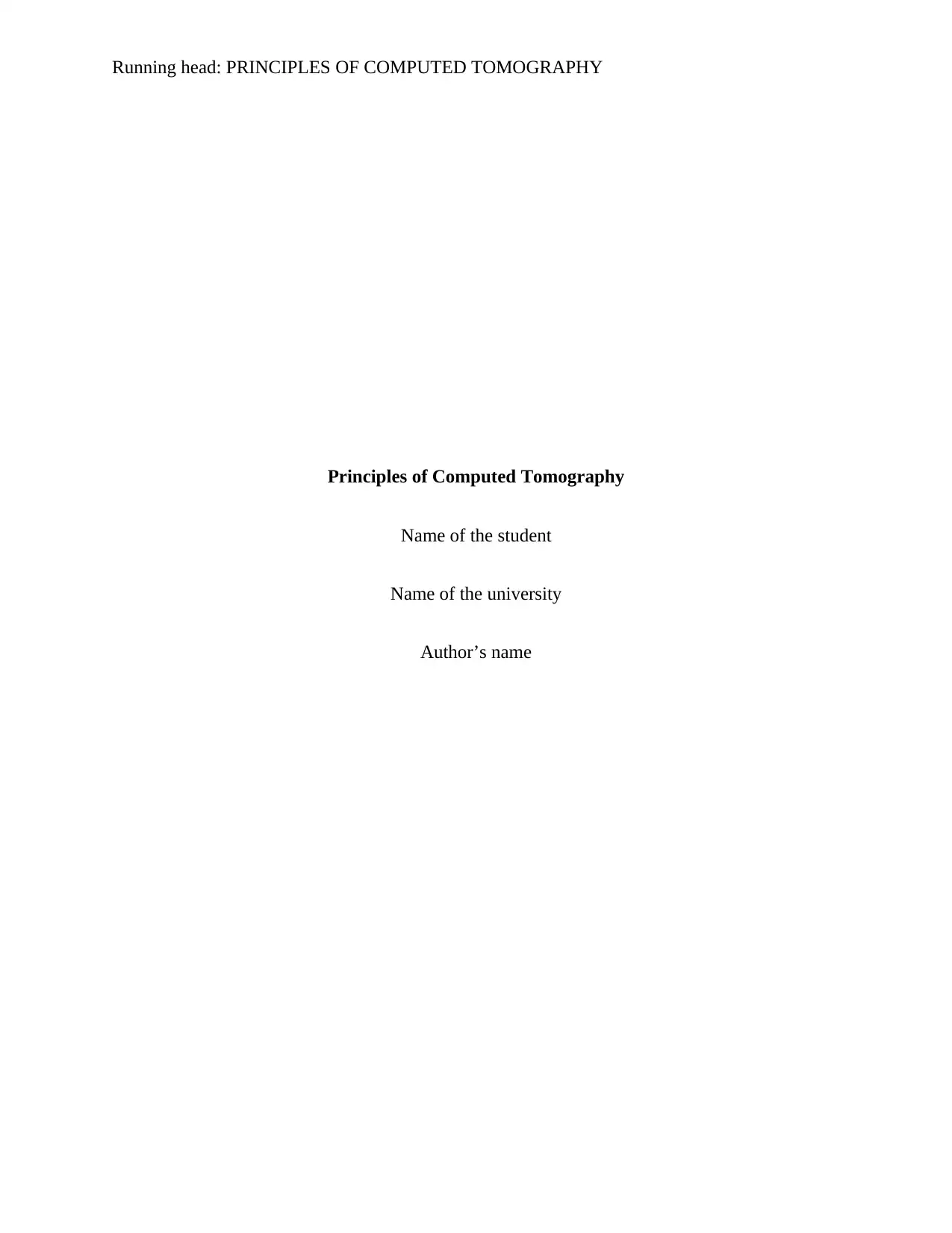
Running head: PRINCIPLES OF COMPUTED TOMOGRAPHY
Principles of Computed Tomography
Name of the student
Name of the university
Author’s name
Principles of Computed Tomography
Name of the student
Name of the university
Author’s name
Secure Best Marks with AI Grader
Need help grading? Try our AI Grader for instant feedback on your assignments.
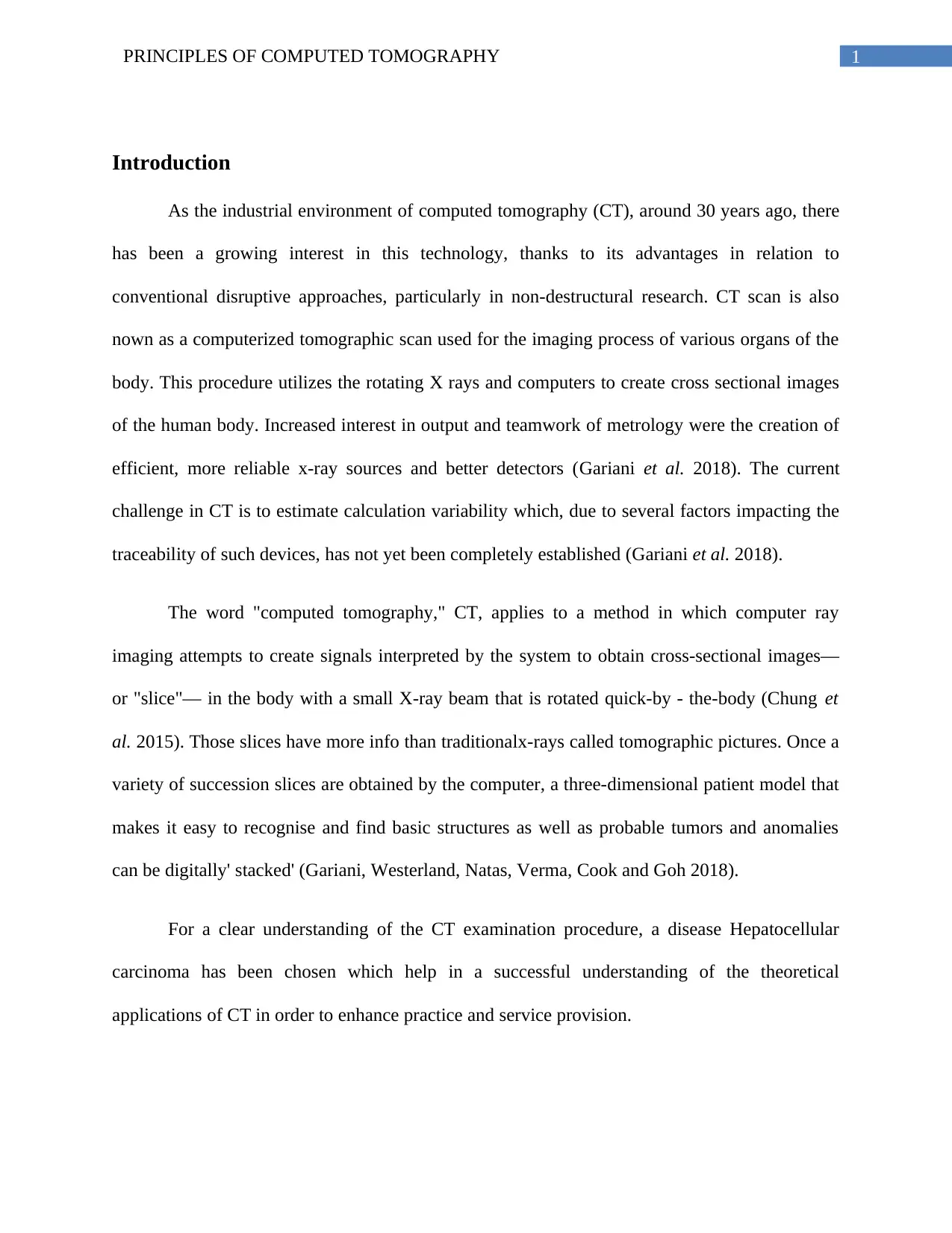
1PRINCIPLES OF COMPUTED TOMOGRAPHY
Introduction
As the industrial environment of computed tomography (CT), around 30 years ago, there
has been a growing interest in this technology, thanks to its advantages in relation to
conventional disruptive approaches, particularly in non-destructural research. CT scan is also
nown as a computerized tomographic scan used for the imaging process of various organs of the
body. This procedure utilizes the rotating X rays and computers to create cross sectional images
of the human body. Increased interest in output and teamwork of metrology were the creation of
efficient, more reliable x-ray sources and better detectors (Gariani et al. 2018). The current
challenge in CT is to estimate calculation variability which, due to several factors impacting the
traceability of such devices, has not yet been completely established (Gariani et al. 2018).
The word "computed tomography," CT, applies to a method in which computer ray
imaging attempts to create signals interpreted by the system to obtain cross-sectional images—
or "slice"— in the body with a small X-ray beam that is rotated quick-by - the-body (Chung et
al. 2015). Those slices have more info than traditionalx-rays called tomographic pictures. Once a
variety of succession slices are obtained by the computer, a three-dimensional patient model that
makes it easy to recognise and find basic structures as well as probable tumors and anomalies
can be digitally' stacked' (Gariani, Westerland, Natas, Verma, Cook and Goh 2018).
For a clear understanding of the CT examination procedure, a disease Hepatocellular
carcinoma has been chosen which help in a successful understanding of the theoretical
applications of CT in order to enhance practice and service provision.
Introduction
As the industrial environment of computed tomography (CT), around 30 years ago, there
has been a growing interest in this technology, thanks to its advantages in relation to
conventional disruptive approaches, particularly in non-destructural research. CT scan is also
nown as a computerized tomographic scan used for the imaging process of various organs of the
body. This procedure utilizes the rotating X rays and computers to create cross sectional images
of the human body. Increased interest in output and teamwork of metrology were the creation of
efficient, more reliable x-ray sources and better detectors (Gariani et al. 2018). The current
challenge in CT is to estimate calculation variability which, due to several factors impacting the
traceability of such devices, has not yet been completely established (Gariani et al. 2018).
The word "computed tomography," CT, applies to a method in which computer ray
imaging attempts to create signals interpreted by the system to obtain cross-sectional images—
or "slice"— in the body with a small X-ray beam that is rotated quick-by - the-body (Chung et
al. 2015). Those slices have more info than traditionalx-rays called tomographic pictures. Once a
variety of succession slices are obtained by the computer, a three-dimensional patient model that
makes it easy to recognise and find basic structures as well as probable tumors and anomalies
can be digitally' stacked' (Gariani, Westerland, Natas, Verma, Cook and Goh 2018).
For a clear understanding of the CT examination procedure, a disease Hepatocellular
carcinoma has been chosen which help in a successful understanding of the theoretical
applications of CT in order to enhance practice and service provision.
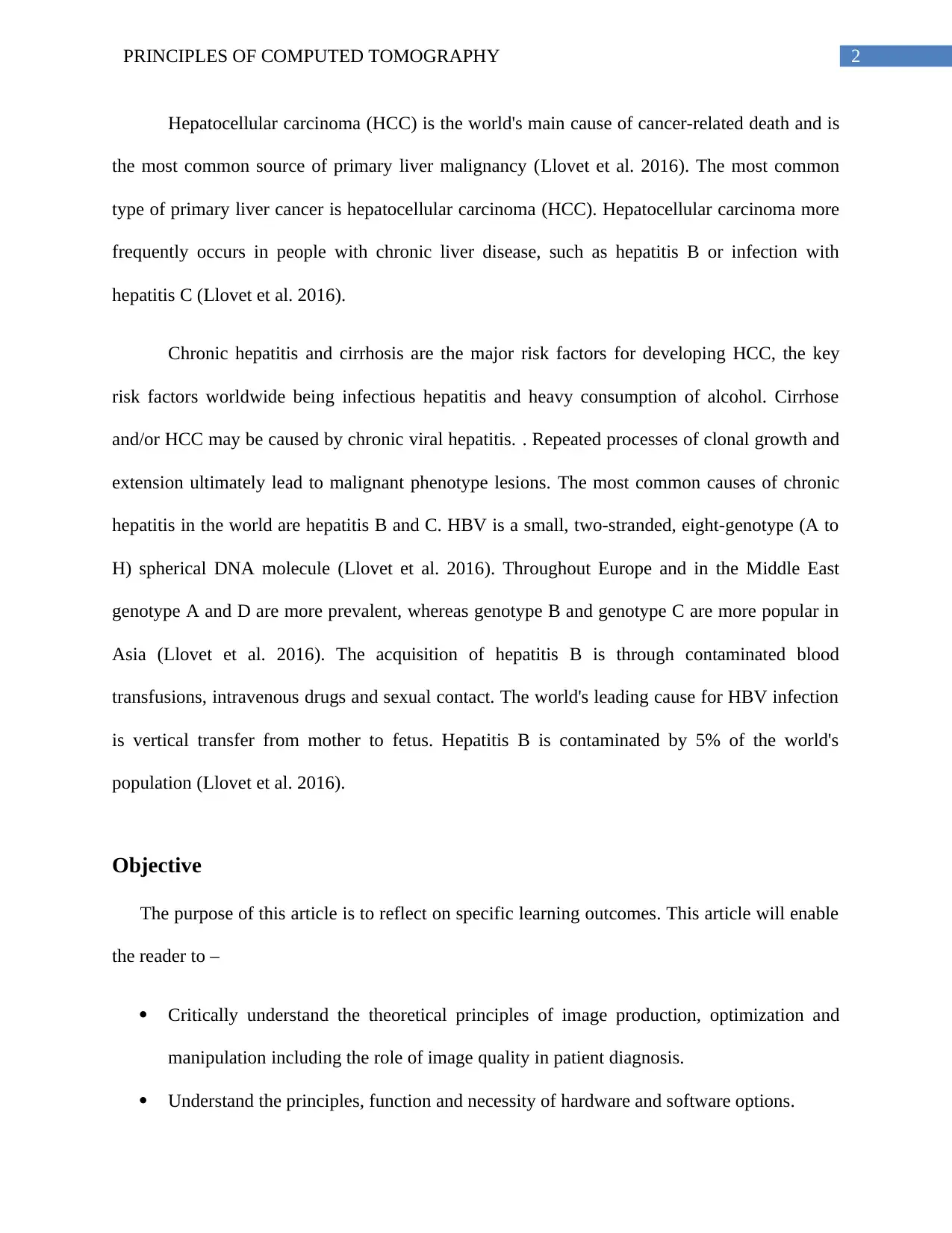
2PRINCIPLES OF COMPUTED TOMOGRAPHY
Hepatocellular carcinoma (HCC) is the world's main cause of cancer-related death and is
the most common source of primary liver malignancy (Llovet et al. 2016). The most common
type of primary liver cancer is hepatocellular carcinoma (HCC). Hepatocellular carcinoma more
frequently occurs in people with chronic liver disease, such as hepatitis B or infection with
hepatitis C (Llovet et al. 2016).
Chronic hepatitis and cirrhosis are the major risk factors for developing HCC, the key
risk factors worldwide being infectious hepatitis and heavy consumption of alcohol. Cirrhose
and/or HCC may be caused by chronic viral hepatitis. . Repeated processes of clonal growth and
extension ultimately lead to malignant phenotype lesions. The most common causes of chronic
hepatitis in the world are hepatitis B and C. HBV is a small, two-stranded, eight-genotype (A to
H) spherical DNA molecule (Llovet et al. 2016). Throughout Europe and in the Middle East
genotype A and D are more prevalent, whereas genotype B and genotype C are more popular in
Asia (Llovet et al. 2016). The acquisition of hepatitis B is through contaminated blood
transfusions, intravenous drugs and sexual contact. The world's leading cause for HBV infection
is vertical transfer from mother to fetus. Hepatitis B is contaminated by 5% of the world's
population (Llovet et al. 2016).
Objective
The purpose of this article is to reflect on specific learning outcomes. This article will enable
the reader to –
Critically understand the theoretical principles of image production, optimization and
manipulation including the role of image quality in patient diagnosis.
Understand the principles, function and necessity of hardware and software options.
Hepatocellular carcinoma (HCC) is the world's main cause of cancer-related death and is
the most common source of primary liver malignancy (Llovet et al. 2016). The most common
type of primary liver cancer is hepatocellular carcinoma (HCC). Hepatocellular carcinoma more
frequently occurs in people with chronic liver disease, such as hepatitis B or infection with
hepatitis C (Llovet et al. 2016).
Chronic hepatitis and cirrhosis are the major risk factors for developing HCC, the key
risk factors worldwide being infectious hepatitis and heavy consumption of alcohol. Cirrhose
and/or HCC may be caused by chronic viral hepatitis. . Repeated processes of clonal growth and
extension ultimately lead to malignant phenotype lesions. The most common causes of chronic
hepatitis in the world are hepatitis B and C. HBV is a small, two-stranded, eight-genotype (A to
H) spherical DNA molecule (Llovet et al. 2016). Throughout Europe and in the Middle East
genotype A and D are more prevalent, whereas genotype B and genotype C are more popular in
Asia (Llovet et al. 2016). The acquisition of hepatitis B is through contaminated blood
transfusions, intravenous drugs and sexual contact. The world's leading cause for HBV infection
is vertical transfer from mother to fetus. Hepatitis B is contaminated by 5% of the world's
population (Llovet et al. 2016).
Objective
The purpose of this article is to reflect on specific learning outcomes. This article will enable
the reader to –
Critically understand the theoretical principles of image production, optimization and
manipulation including the role of image quality in patient diagnosis.
Understand the principles, function and necessity of hardware and software options.
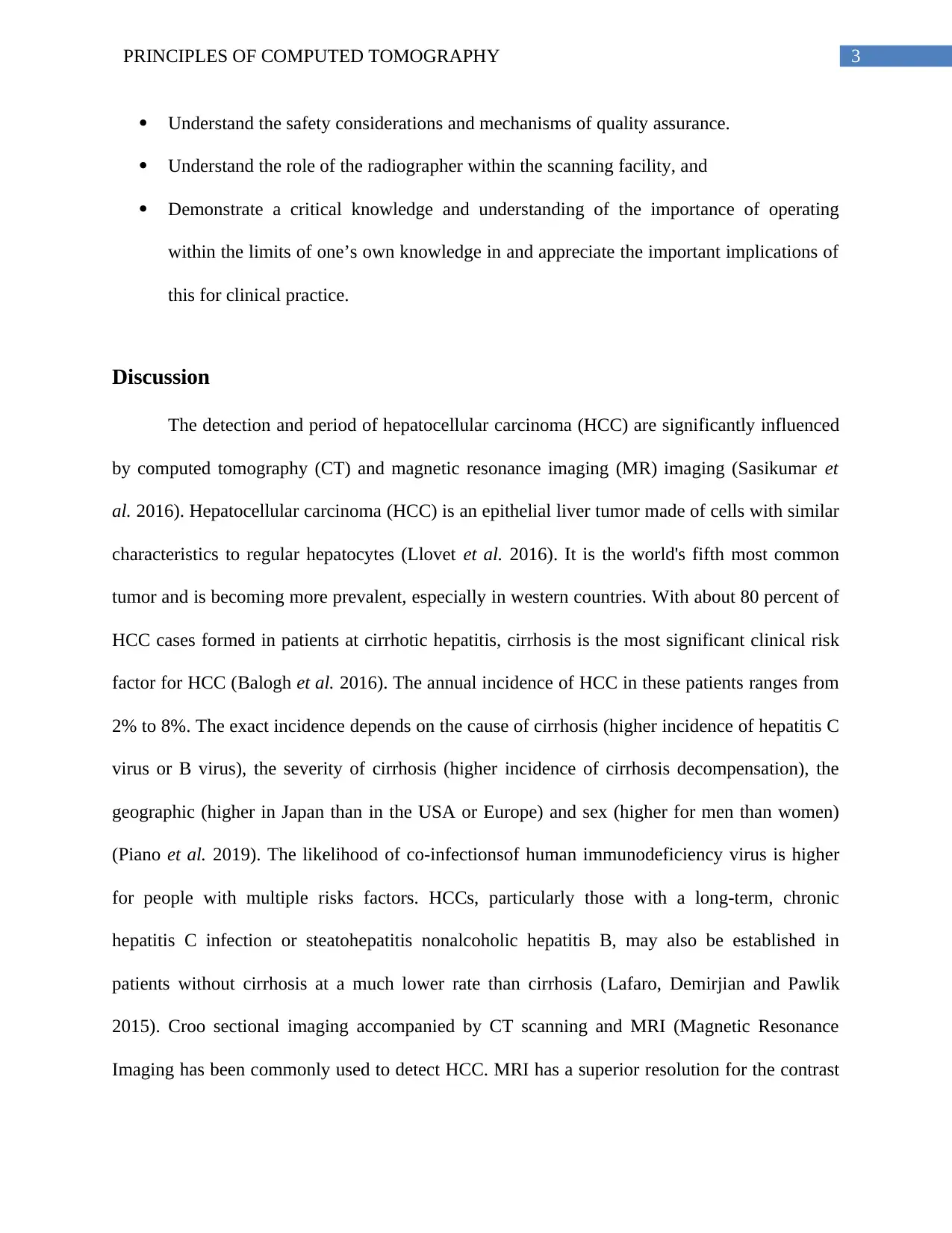
3PRINCIPLES OF COMPUTED TOMOGRAPHY
Understand the safety considerations and mechanisms of quality assurance.
Understand the role of the radiographer within the scanning facility, and
Demonstrate a critical knowledge and understanding of the importance of operating
within the limits of one’s own knowledge in and appreciate the important implications of
this for clinical practice.
Discussion
The detection and period of hepatocellular carcinoma (HCC) are significantly influenced
by computed tomography (CT) and magnetic resonance imaging (MR) imaging (Sasikumar et
al. 2016). Hepatocellular carcinoma (HCC) is an epithelial liver tumor made of cells with similar
characteristics to regular hepatocytes (Llovet et al. 2016). It is the world's fifth most common
tumor and is becoming more prevalent, especially in western countries. With about 80 percent of
HCC cases formed in patients at cirrhotic hepatitis, cirrhosis is the most significant clinical risk
factor for HCC (Balogh et al. 2016). The annual incidence of HCC in these patients ranges from
2% to 8%. The exact incidence depends on the cause of cirrhosis (higher incidence of hepatitis C
virus or B virus), the severity of cirrhosis (higher incidence of cirrhosis decompensation), the
geographic (higher in Japan than in the USA or Europe) and sex (higher for men than women)
(Piano et al. 2019). The likelihood of co-infectionsof human immunodeficiency virus is higher
for people with multiple risks factors. HCCs, particularly those with a long-term, chronic
hepatitis C infection or steatohepatitis nonalcoholic hepatitis B, may also be established in
patients without cirrhosis at a much lower rate than cirrhosis (Lafaro, Demirjian and Pawlik
2015). Croo sectional imaging accompanied by CT scanning and MRI (Magnetic Resonance
Imaging has been commonly used to detect HCC. MRI has a superior resolution for the contrast
Understand the safety considerations and mechanisms of quality assurance.
Understand the role of the radiographer within the scanning facility, and
Demonstrate a critical knowledge and understanding of the importance of operating
within the limits of one’s own knowledge in and appreciate the important implications of
this for clinical practice.
Discussion
The detection and period of hepatocellular carcinoma (HCC) are significantly influenced
by computed tomography (CT) and magnetic resonance imaging (MR) imaging (Sasikumar et
al. 2016). Hepatocellular carcinoma (HCC) is an epithelial liver tumor made of cells with similar
characteristics to regular hepatocytes (Llovet et al. 2016). It is the world's fifth most common
tumor and is becoming more prevalent, especially in western countries. With about 80 percent of
HCC cases formed in patients at cirrhotic hepatitis, cirrhosis is the most significant clinical risk
factor for HCC (Balogh et al. 2016). The annual incidence of HCC in these patients ranges from
2% to 8%. The exact incidence depends on the cause of cirrhosis (higher incidence of hepatitis C
virus or B virus), the severity of cirrhosis (higher incidence of cirrhosis decompensation), the
geographic (higher in Japan than in the USA or Europe) and sex (higher for men than women)
(Piano et al. 2019). The likelihood of co-infectionsof human immunodeficiency virus is higher
for people with multiple risks factors. HCCs, particularly those with a long-term, chronic
hepatitis C infection or steatohepatitis nonalcoholic hepatitis B, may also be established in
patients without cirrhosis at a much lower rate than cirrhosis (Lafaro, Demirjian and Pawlik
2015). Croo sectional imaging accompanied by CT scanning and MRI (Magnetic Resonance
Imaging has been commonly used to detect HCC. MRI has a superior resolution for the contrast
Secure Best Marks with AI Grader
Need help grading? Try our AI Grader for instant feedback on your assignments.
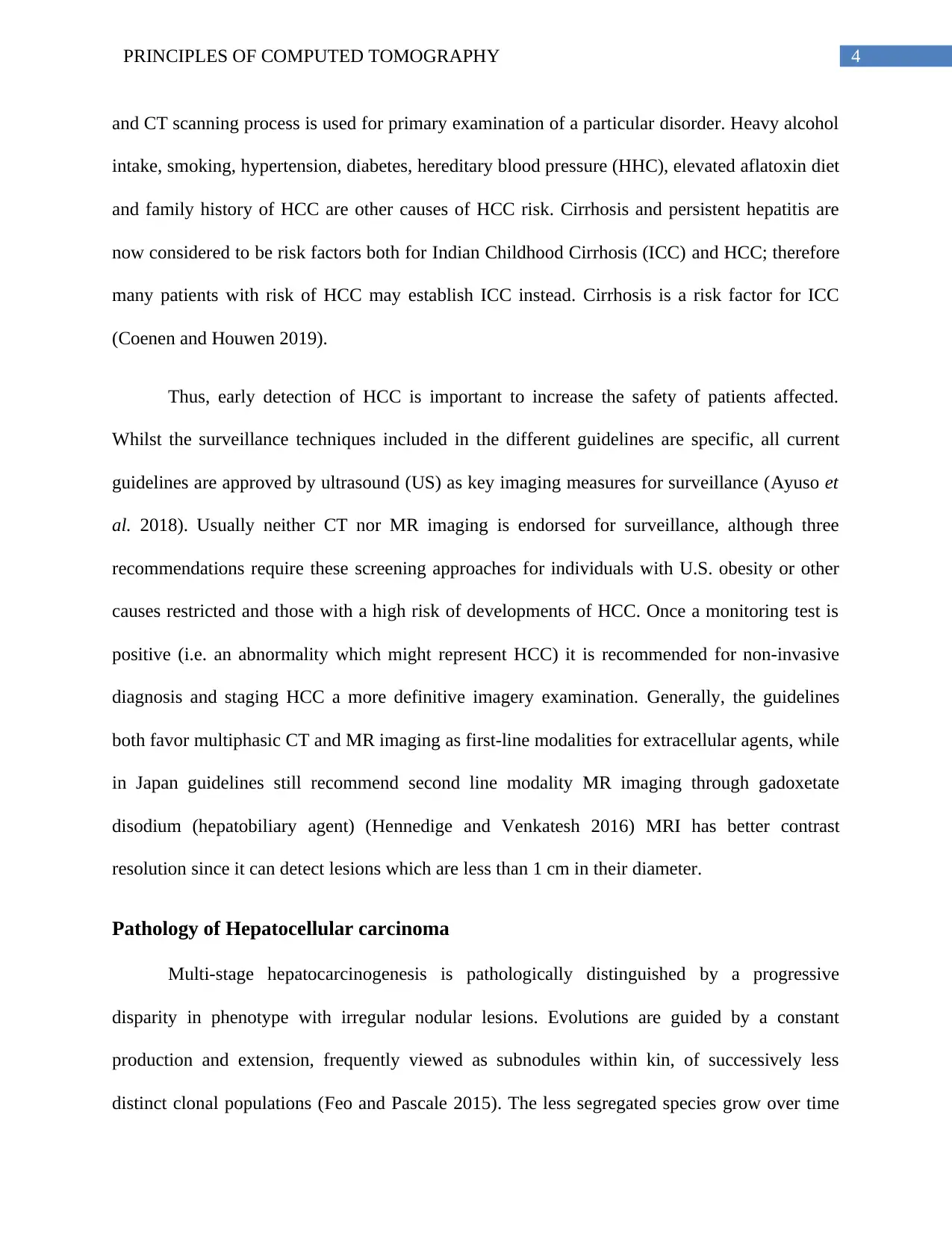
4PRINCIPLES OF COMPUTED TOMOGRAPHY
and CT scanning process is used for primary examination of a particular disorder. Heavy alcohol
intake, smoking, hypertension, diabetes, hereditary blood pressure (HHC), elevated aflatoxin diet
and family history of HCC are other causes of HCC risk. Cirrhosis and persistent hepatitis are
now considered to be risk factors both for Indian Childhood Cirrhosis (ICC) and HCC; therefore
many patients with risk of HCC may establish ICC instead. Cirrhosis is a risk factor for ICC
(Coenen and Houwen 2019).
Thus, early detection of HCC is important to increase the safety of patients affected.
Whilst the surveillance techniques included in the different guidelines are specific, all current
guidelines are approved by ultrasound (US) as key imaging measures for surveillance (Ayuso et
al. 2018). Usually neither CT nor MR imaging is endorsed for surveillance, although three
recommendations require these screening approaches for individuals with U.S. obesity or other
causes restricted and those with a high risk of developments of HCC. Once a monitoring test is
positive (i.e. an abnormality which might represent HCC) it is recommended for non-invasive
diagnosis and staging HCC a more definitive imagery examination. Generally, the guidelines
both favor multiphasic CT and MR imaging as first-line modalities for extracellular agents, while
in Japan guidelines still recommend second line modality MR imaging through gadoxetate
disodium (hepatobiliary agent) (Hennedige and Venkatesh 2016) MRI has better contrast
resolution since it can detect lesions which are less than 1 cm in their diameter.
Pathology of Hepatocellular carcinoma
Multi-stage hepatocarcinogenesis is pathologically distinguished by a progressive
disparity in phenotype with irregular nodular lesions. Evolutions are guided by a constant
production and extension, frequently viewed as subnodules within kin, of successively less
distinct clonal populations (Feo and Pascale 2015). The less segregated species grow over time
and CT scanning process is used for primary examination of a particular disorder. Heavy alcohol
intake, smoking, hypertension, diabetes, hereditary blood pressure (HHC), elevated aflatoxin diet
and family history of HCC are other causes of HCC risk. Cirrhosis and persistent hepatitis are
now considered to be risk factors both for Indian Childhood Cirrhosis (ICC) and HCC; therefore
many patients with risk of HCC may establish ICC instead. Cirrhosis is a risk factor for ICC
(Coenen and Houwen 2019).
Thus, early detection of HCC is important to increase the safety of patients affected.
Whilst the surveillance techniques included in the different guidelines are specific, all current
guidelines are approved by ultrasound (US) as key imaging measures for surveillance (Ayuso et
al. 2018). Usually neither CT nor MR imaging is endorsed for surveillance, although three
recommendations require these screening approaches for individuals with U.S. obesity or other
causes restricted and those with a high risk of developments of HCC. Once a monitoring test is
positive (i.e. an abnormality which might represent HCC) it is recommended for non-invasive
diagnosis and staging HCC a more definitive imagery examination. Generally, the guidelines
both favor multiphasic CT and MR imaging as first-line modalities for extracellular agents, while
in Japan guidelines still recommend second line modality MR imaging through gadoxetate
disodium (hepatobiliary agent) (Hennedige and Venkatesh 2016) MRI has better contrast
resolution since it can detect lesions which are less than 1 cm in their diameter.
Pathology of Hepatocellular carcinoma
Multi-stage hepatocarcinogenesis is pathologically distinguished by a progressive
disparity in phenotype with irregular nodular lesions. Evolutions are guided by a constant
production and extension, frequently viewed as subnodules within kin, of successively less
distinct clonal populations (Feo and Pascale 2015). The less segregated species grow over time
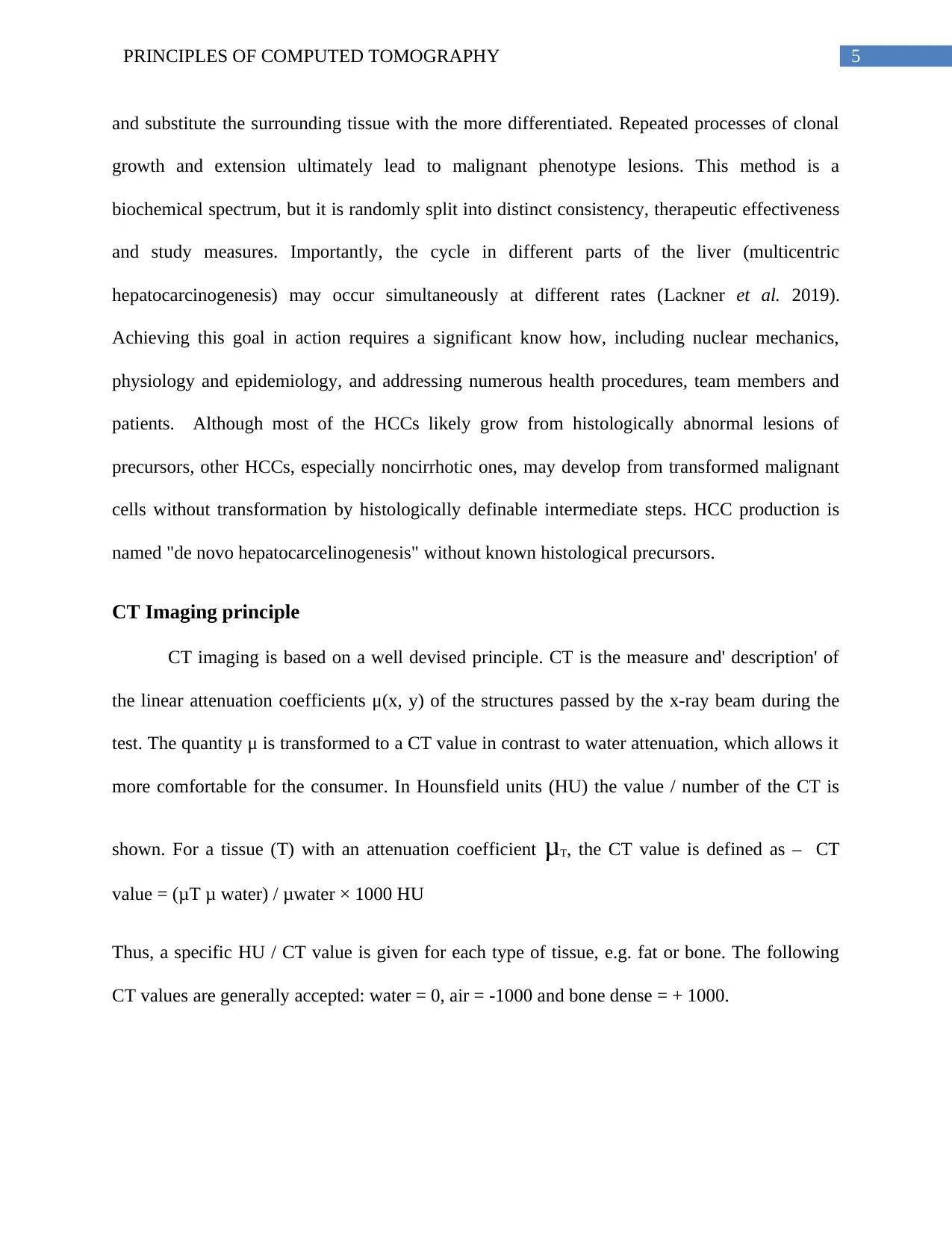
5PRINCIPLES OF COMPUTED TOMOGRAPHY
and substitute the surrounding tissue with the more differentiated. Repeated processes of clonal
growth and extension ultimately lead to malignant phenotype lesions. This method is a
biochemical spectrum, but it is randomly split into distinct consistency, therapeutic effectiveness
and study measures. Importantly, the cycle in different parts of the liver (multicentric
hepatocarcinogenesis) may occur simultaneously at different rates (Lackner et al. 2019).
Achieving this goal in action requires a significant know how, including nuclear mechanics,
physiology and epidemiology, and addressing numerous health procedures, team members and
patients. Although most of the HCCs likely grow from histologically abnormal lesions of
precursors, other HCCs, especially noncirrhotic ones, may develop from transformed malignant
cells without transformation by histologically definable intermediate steps. HCC production is
named "de novo hepatocarcelinogenesis" without known histological precursors.
CT Imaging principle
CT imaging is based on a well devised principle. CT is the measure and' description' of
the linear attenuation coefficients μ(x, y) of the structures passed by the x-ray beam during the
test. The quantity μ is transformed to a CT value in contrast to water attenuation, which allows it
more comfortable for the consumer. In Hounsfield units (HU) the value / number of the CT is
shown. For a tissue (T) with an attenuation coefficient μT, the CT value is defined as – CT
value = (μT μ water) / μwater × 1000 HU
Thus, a specific HU / CT value is given for each type of tissue, e.g. fat or bone. The following
CT values are generally accepted: water = 0, air = -1000 and bone dense = + 1000.
and substitute the surrounding tissue with the more differentiated. Repeated processes of clonal
growth and extension ultimately lead to malignant phenotype lesions. This method is a
biochemical spectrum, but it is randomly split into distinct consistency, therapeutic effectiveness
and study measures. Importantly, the cycle in different parts of the liver (multicentric
hepatocarcinogenesis) may occur simultaneously at different rates (Lackner et al. 2019).
Achieving this goal in action requires a significant know how, including nuclear mechanics,
physiology and epidemiology, and addressing numerous health procedures, team members and
patients. Although most of the HCCs likely grow from histologically abnormal lesions of
precursors, other HCCs, especially noncirrhotic ones, may develop from transformed malignant
cells without transformation by histologically definable intermediate steps. HCC production is
named "de novo hepatocarcelinogenesis" without known histological precursors.
CT Imaging principle
CT imaging is based on a well devised principle. CT is the measure and' description' of
the linear attenuation coefficients μ(x, y) of the structures passed by the x-ray beam during the
test. The quantity μ is transformed to a CT value in contrast to water attenuation, which allows it
more comfortable for the consumer. In Hounsfield units (HU) the value / number of the CT is
shown. For a tissue (T) with an attenuation coefficient μT, the CT value is defined as – CT
value = (μT μ water) / μwater × 1000 HU
Thus, a specific HU / CT value is given for each type of tissue, e.g. fat or bone. The following
CT values are generally accepted: water = 0, air = -1000 and bone dense = + 1000.
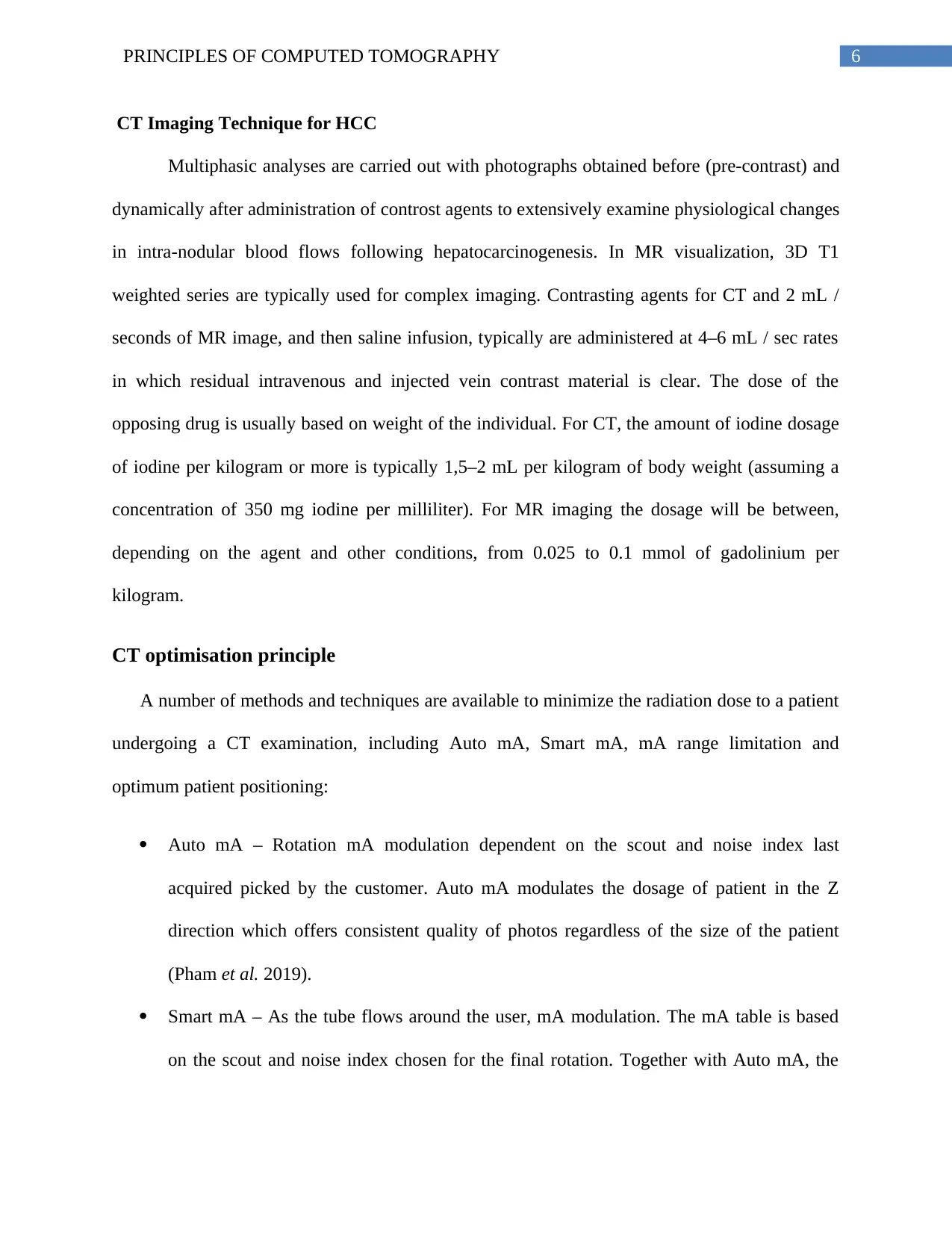
6PRINCIPLES OF COMPUTED TOMOGRAPHY
CT Imaging Technique for HCC
Multiphasic analyses are carried out with photographs obtained before (pre-contrast) and
dynamically after administration of controst agents to extensively examine physiological changes
in intra-nodular blood flows following hepatocarcinogenesis. In MR visualization, 3D T1
weighted series are typically used for complex imaging. Contrasting agents for CT and 2 mL /
seconds of MR image, and then saline infusion, typically are administered at 4–6 mL / sec rates
in which residual intravenous and injected vein contrast material is clear. The dose of the
opposing drug is usually based on weight of the individual. For CT, the amount of iodine dosage
of iodine per kilogram or more is typically 1,5–2 mL per kilogram of body weight (assuming a
concentration of 350 mg iodine per milliliter). For MR imaging the dosage will be between,
depending on the agent and other conditions, from 0.025 to 0.1 mmol of gadolinium per
kilogram.
CT optimisation principle
A number of methods and techniques are available to minimize the radiation dose to a patient
undergoing a CT examination, including Auto mA, Smart mA, mA range limitation and
optimum patient positioning:
Auto mA – Rotation mA modulation dependent on the scout and noise index last
acquired picked by the customer. Auto mA modulates the dosage of patient in the Z
direction which offers consistent quality of photos regardless of the size of the patient
(Pham et al. 2019).
Smart mA – As the tube flows around the user, mA modulation. The mA table is based
on the scout and noise index chosen for the final rotation. Together with Auto mA, the
CT Imaging Technique for HCC
Multiphasic analyses are carried out with photographs obtained before (pre-contrast) and
dynamically after administration of controst agents to extensively examine physiological changes
in intra-nodular blood flows following hepatocarcinogenesis. In MR visualization, 3D T1
weighted series are typically used for complex imaging. Contrasting agents for CT and 2 mL /
seconds of MR image, and then saline infusion, typically are administered at 4–6 mL / sec rates
in which residual intravenous and injected vein contrast material is clear. The dose of the
opposing drug is usually based on weight of the individual. For CT, the amount of iodine dosage
of iodine per kilogram or more is typically 1,5–2 mL per kilogram of body weight (assuming a
concentration of 350 mg iodine per milliliter). For MR imaging the dosage will be between,
depending on the agent and other conditions, from 0.025 to 0.1 mmol of gadolinium per
kilogram.
CT optimisation principle
A number of methods and techniques are available to minimize the radiation dose to a patient
undergoing a CT examination, including Auto mA, Smart mA, mA range limitation and
optimum patient positioning:
Auto mA – Rotation mA modulation dependent on the scout and noise index last
acquired picked by the customer. Auto mA modulates the dosage of patient in the Z
direction which offers consistent quality of photos regardless of the size of the patient
(Pham et al. 2019).
Smart mA – As the tube flows around the user, mA modulation. The mA table is based
on the scout and noise index chosen for the final rotation. Together with Auto mA, the
Paraphrase This Document
Need a fresh take? Get an instant paraphrase of this document with our AI Paraphraser
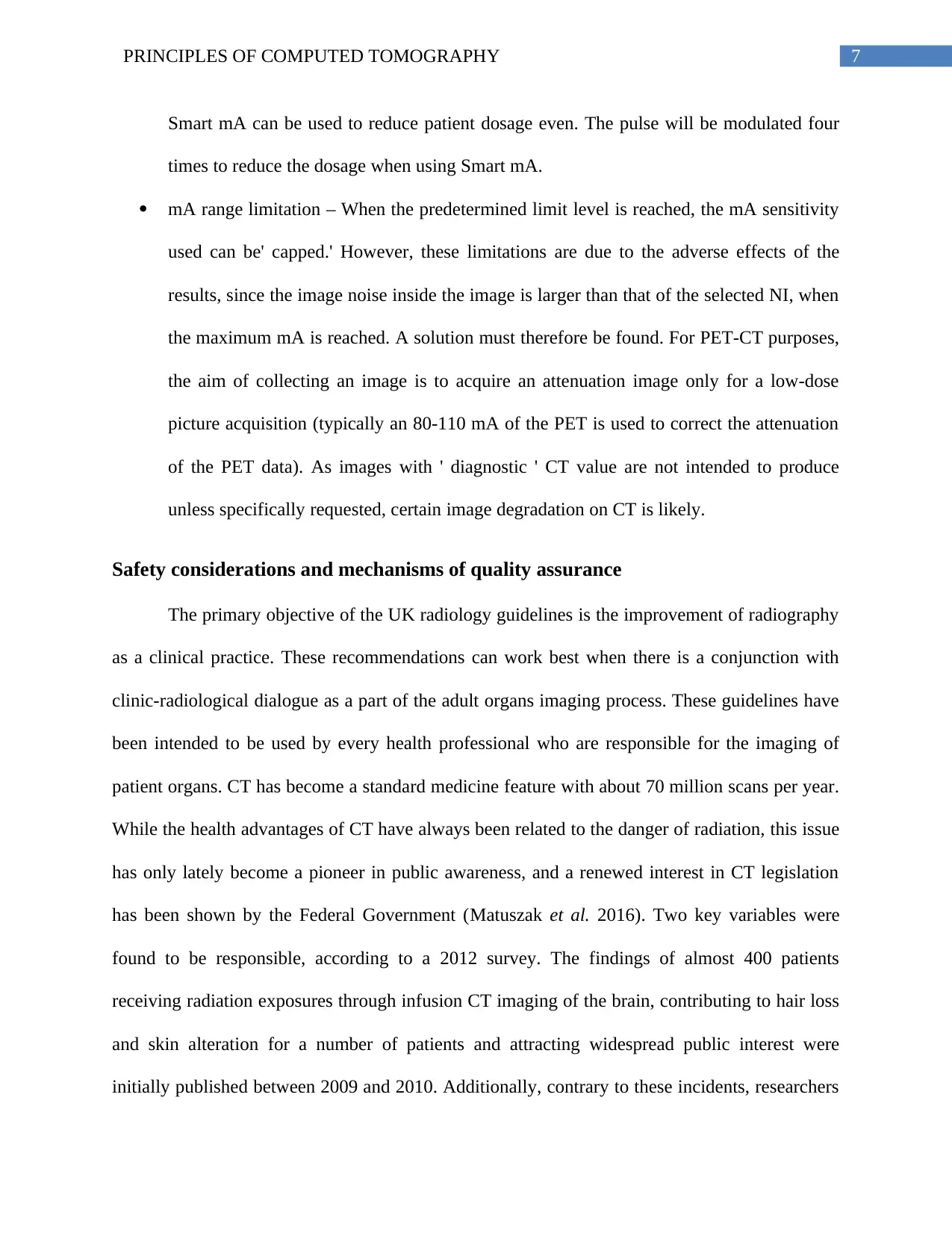
7PRINCIPLES OF COMPUTED TOMOGRAPHY
Smart mA can be used to reduce patient dosage even. The pulse will be modulated four
times to reduce the dosage when using Smart mA.
mA range limitation – When the predetermined limit level is reached, the mA sensitivity
used can be' capped.' However, these limitations are due to the adverse effects of the
results, since the image noise inside the image is larger than that of the selected NI, when
the maximum mA is reached. A solution must therefore be found. For PET-CT purposes,
the aim of collecting an image is to acquire an attenuation image only for a low-dose
picture acquisition (typically an 80-110 mA of the PET is used to correct the attenuation
of the PET data). As images with ' diagnostic ' CT value are not intended to produce
unless specifically requested, certain image degradation on CT is likely.
Safety considerations and mechanisms of quality assurance
The primary objective of the UK radiology guidelines is the improvement of radiography
as a clinical practice. These recommendations can work best when there is a conjunction with
clinic-radiological dialogue as a part of the adult organs imaging process. These guidelines have
been intended to be used by every health professional who are responsible for the imaging of
patient organs. CT has become a standard medicine feature with about 70 million scans per year.
While the health advantages of CT have always been related to the danger of radiation, this issue
has only lately become a pioneer in public awareness, and a renewed interest in CT legislation
has been shown by the Federal Government (Matuszak et al. 2016). Two key variables were
found to be responsible, according to a 2012 survey. The findings of almost 400 patients
receiving radiation exposures through infusion CT imaging of the brain, contributing to hair loss
and skin alteration for a number of patients and attracting widespread public interest were
initially published between 2009 and 2010. Additionally, contrary to these incidents, researchers
Smart mA can be used to reduce patient dosage even. The pulse will be modulated four
times to reduce the dosage when using Smart mA.
mA range limitation – When the predetermined limit level is reached, the mA sensitivity
used can be' capped.' However, these limitations are due to the adverse effects of the
results, since the image noise inside the image is larger than that of the selected NI, when
the maximum mA is reached. A solution must therefore be found. For PET-CT purposes,
the aim of collecting an image is to acquire an attenuation image only for a low-dose
picture acquisition (typically an 80-110 mA of the PET is used to correct the attenuation
of the PET data). As images with ' diagnostic ' CT value are not intended to produce
unless specifically requested, certain image degradation on CT is likely.
Safety considerations and mechanisms of quality assurance
The primary objective of the UK radiology guidelines is the improvement of radiography
as a clinical practice. These recommendations can work best when there is a conjunction with
clinic-radiological dialogue as a part of the adult organs imaging process. These guidelines have
been intended to be used by every health professional who are responsible for the imaging of
patient organs. CT has become a standard medicine feature with about 70 million scans per year.
While the health advantages of CT have always been related to the danger of radiation, this issue
has only lately become a pioneer in public awareness, and a renewed interest in CT legislation
has been shown by the Federal Government (Matuszak et al. 2016). Two key variables were
found to be responsible, according to a 2012 survey. The findings of almost 400 patients
receiving radiation exposures through infusion CT imaging of the brain, contributing to hair loss
and skin alteration for a number of patients and attracting widespread public interest were
initially published between 2009 and 2010. Additionally, contrary to these incidents, researchers
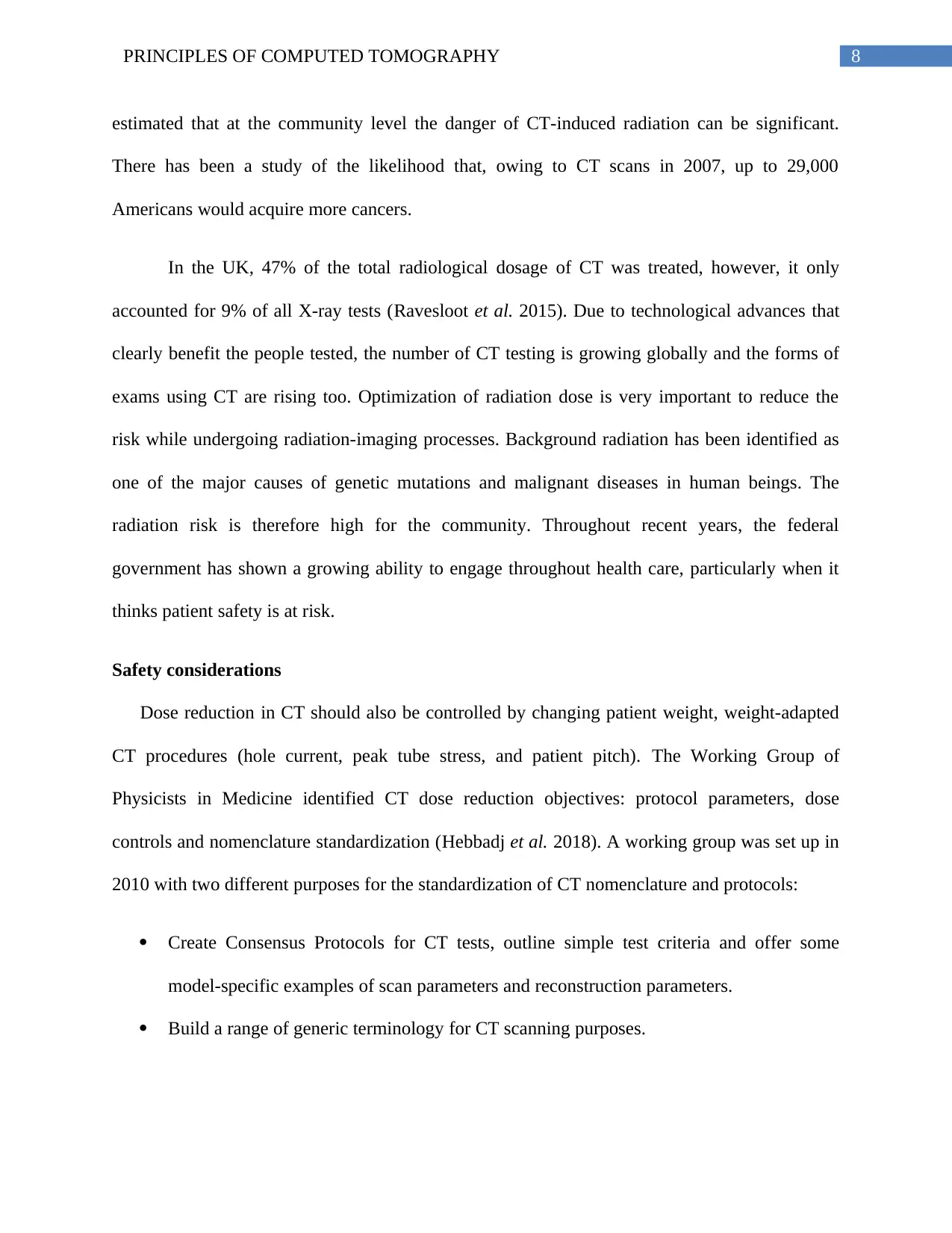
8PRINCIPLES OF COMPUTED TOMOGRAPHY
estimated that at the community level the danger of CT-induced radiation can be significant.
There has been a study of the likelihood that, owing to CT scans in 2007, up to 29,000
Americans would acquire more cancers.
In the UK, 47% of the total radiological dosage of CT was treated, however, it only
accounted for 9% of all X-ray tests (Ravesloot et al. 2015). Due to technological advances that
clearly benefit the people tested, the number of CT testing is growing globally and the forms of
exams using CT are rising too. Optimization of radiation dose is very important to reduce the
risk while undergoing radiation-imaging processes. Background radiation has been identified as
one of the major causes of genetic mutations and malignant diseases in human beings. The
radiation risk is therefore high for the community. Throughout recent years, the federal
government has shown a growing ability to engage throughout health care, particularly when it
thinks patient safety is at risk.
Safety considerations
Dose reduction in CT should also be controlled by changing patient weight, weight-adapted
CT procedures (hole current, peak tube stress, and patient pitch). The Working Group of
Physicists in Medicine identified CT dose reduction objectives: protocol parameters, dose
controls and nomenclature standardization (Hebbadj et al. 2018). A working group was set up in
2010 with two different purposes for the standardization of CT nomenclature and protocols:
Create Consensus Protocols for CT tests, outline simple test criteria and offer some
model-specific examples of scan parameters and reconstruction parameters.
Build a range of generic terminology for CT scanning purposes.
estimated that at the community level the danger of CT-induced radiation can be significant.
There has been a study of the likelihood that, owing to CT scans in 2007, up to 29,000
Americans would acquire more cancers.
In the UK, 47% of the total radiological dosage of CT was treated, however, it only
accounted for 9% of all X-ray tests (Ravesloot et al. 2015). Due to technological advances that
clearly benefit the people tested, the number of CT testing is growing globally and the forms of
exams using CT are rising too. Optimization of radiation dose is very important to reduce the
risk while undergoing radiation-imaging processes. Background radiation has been identified as
one of the major causes of genetic mutations and malignant diseases in human beings. The
radiation risk is therefore high for the community. Throughout recent years, the federal
government has shown a growing ability to engage throughout health care, particularly when it
thinks patient safety is at risk.
Safety considerations
Dose reduction in CT should also be controlled by changing patient weight, weight-adapted
CT procedures (hole current, peak tube stress, and patient pitch). The Working Group of
Physicists in Medicine identified CT dose reduction objectives: protocol parameters, dose
controls and nomenclature standardization (Hebbadj et al. 2018). A working group was set up in
2010 with two different purposes for the standardization of CT nomenclature and protocols:
Create Consensus Protocols for CT tests, outline simple test criteria and offer some
model-specific examples of scan parameters and reconstruction parameters.
Build a range of generic terminology for CT scanning purposes.
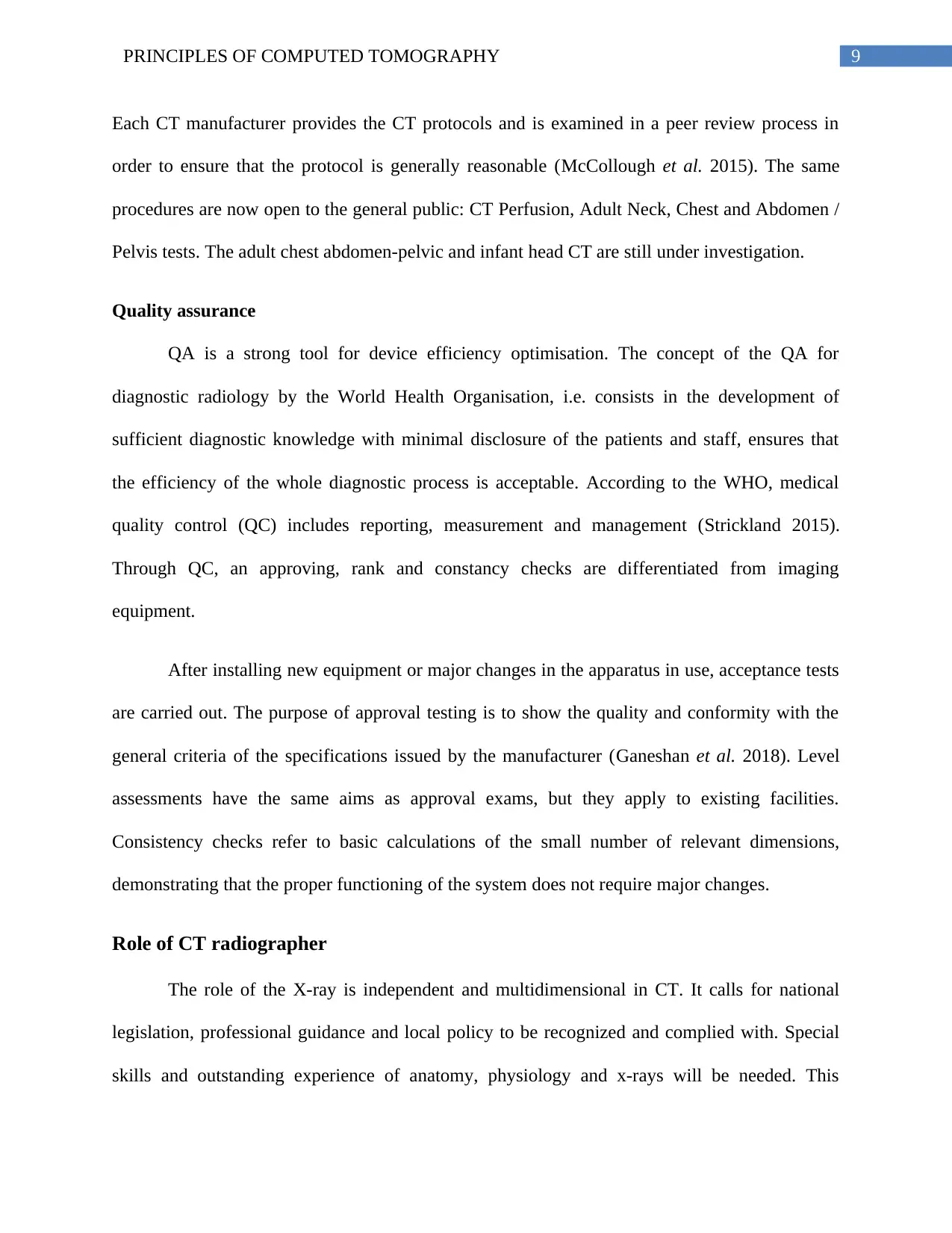
9PRINCIPLES OF COMPUTED TOMOGRAPHY
Each CT manufacturer provides the CT protocols and is examined in a peer review process in
order to ensure that the protocol is generally reasonable (McCollough et al. 2015). The same
procedures are now open to the general public: CT Perfusion, Adult Neck, Chest and Abdomen /
Pelvis tests. The adult chest abdomen-pelvic and infant head CT are still under investigation.
Quality assurance
QA is a strong tool for device efficiency optimisation. The concept of the QA for
diagnostic radiology by the World Health Organisation, i.e. consists in the development of
sufficient diagnostic knowledge with minimal disclosure of the patients and staff, ensures that
the efficiency of the whole diagnostic process is acceptable. According to the WHO, medical
quality control (QC) includes reporting, measurement and management (Strickland 2015).
Through QC, an approving, rank and constancy checks are differentiated from imaging
equipment.
After installing new equipment or major changes in the apparatus in use, acceptance tests
are carried out. The purpose of approval testing is to show the quality and conformity with the
general criteria of the specifications issued by the manufacturer (Ganeshan et al. 2018). Level
assessments have the same aims as approval exams, but they apply to existing facilities.
Consistency checks refer to basic calculations of the small number of relevant dimensions,
demonstrating that the proper functioning of the system does not require major changes.
Role of CT radiographer
The role of the X-ray is independent and multidimensional in CT. It calls for national
legislation, professional guidance and local policy to be recognized and complied with. Special
skills and outstanding experience of anatomy, physiology and x-rays will be needed. This
Each CT manufacturer provides the CT protocols and is examined in a peer review process in
order to ensure that the protocol is generally reasonable (McCollough et al. 2015). The same
procedures are now open to the general public: CT Perfusion, Adult Neck, Chest and Abdomen /
Pelvis tests. The adult chest abdomen-pelvic and infant head CT are still under investigation.
Quality assurance
QA is a strong tool for device efficiency optimisation. The concept of the QA for
diagnostic radiology by the World Health Organisation, i.e. consists in the development of
sufficient diagnostic knowledge with minimal disclosure of the patients and staff, ensures that
the efficiency of the whole diagnostic process is acceptable. According to the WHO, medical
quality control (QC) includes reporting, measurement and management (Strickland 2015).
Through QC, an approving, rank and constancy checks are differentiated from imaging
equipment.
After installing new equipment or major changes in the apparatus in use, acceptance tests
are carried out. The purpose of approval testing is to show the quality and conformity with the
general criteria of the specifications issued by the manufacturer (Ganeshan et al. 2018). Level
assessments have the same aims as approval exams, but they apply to existing facilities.
Consistency checks refer to basic calculations of the small number of relevant dimensions,
demonstrating that the proper functioning of the system does not require major changes.
Role of CT radiographer
The role of the X-ray is independent and multidimensional in CT. It calls for national
legislation, professional guidance and local policy to be recognized and complied with. Special
skills and outstanding experience of anatomy, physiology and x-rays will be needed. This
Secure Best Marks with AI Grader
Need help grading? Try our AI Grader for instant feedback on your assignments.
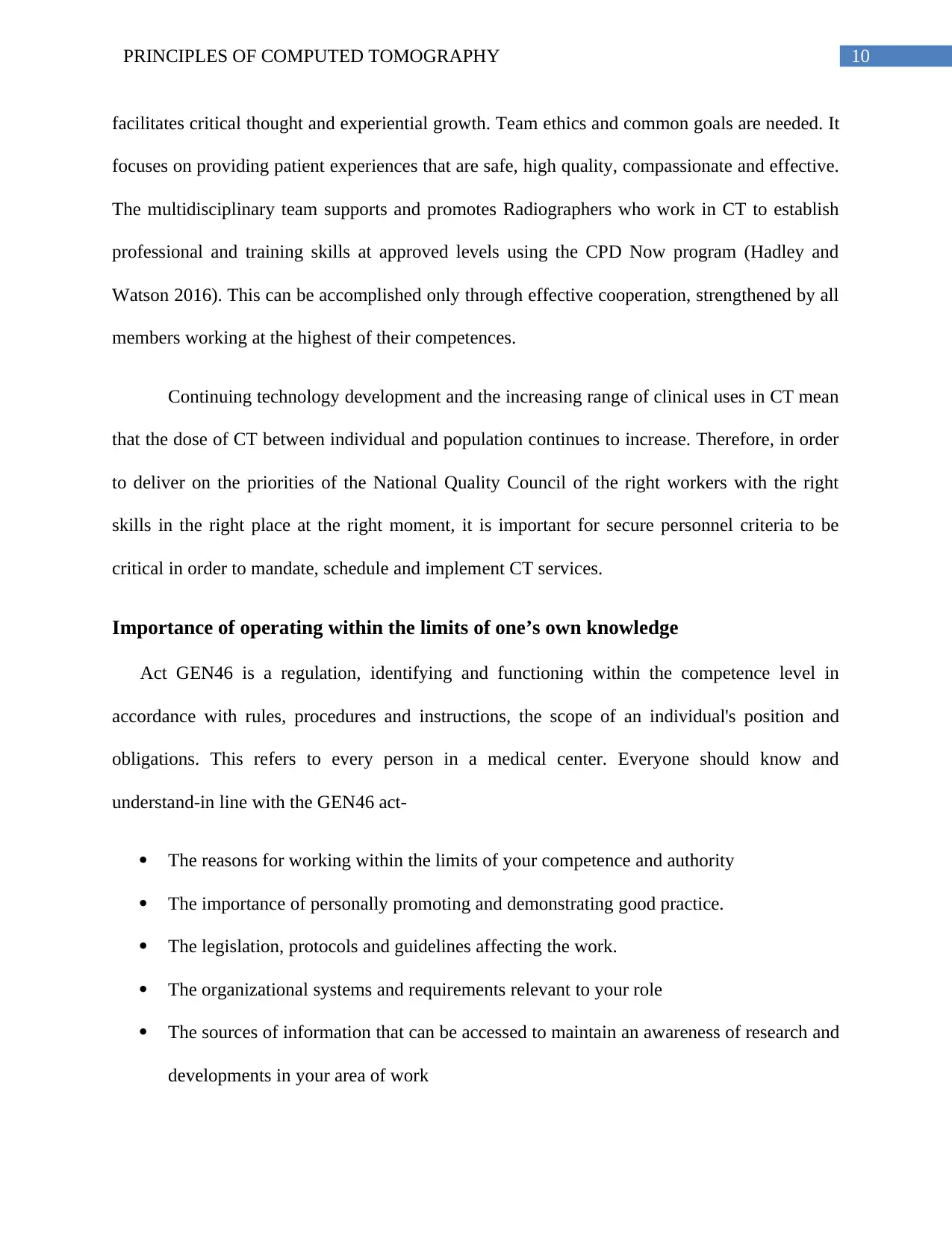
10PRINCIPLES OF COMPUTED TOMOGRAPHY
facilitates critical thought and experiential growth. Team ethics and common goals are needed. It
focuses on providing patient experiences that are safe, high quality, compassionate and effective.
The multidisciplinary team supports and promotes Radiographers who work in CT to establish
professional and training skills at approved levels using the CPD Now program (Hadley and
Watson 2016). This can be accomplished only through effective cooperation, strengthened by all
members working at the highest of their competences.
Continuing technology development and the increasing range of clinical uses in CT mean
that the dose of CT between individual and population continues to increase. Therefore, in order
to deliver on the priorities of the National Quality Council of the right workers with the right
skills in the right place at the right moment, it is important for secure personnel criteria to be
critical in order to mandate, schedule and implement CT services.
Importance of operating within the limits of one’s own knowledge
Act GEN46 is a regulation, identifying and functioning within the competence level in
accordance with rules, procedures and instructions, the scope of an individual's position and
obligations. This refers to every person in a medical center. Everyone should know and
understand-in line with the GEN46 act-
The reasons for working within the limits of your competence and authority
The importance of personally promoting and demonstrating good practice.
The legislation, protocols and guidelines affecting the work.
The organizational systems and requirements relevant to your role
The sources of information that can be accessed to maintain an awareness of research and
developments in your area of work
facilitates critical thought and experiential growth. Team ethics and common goals are needed. It
focuses on providing patient experiences that are safe, high quality, compassionate and effective.
The multidisciplinary team supports and promotes Radiographers who work in CT to establish
professional and training skills at approved levels using the CPD Now program (Hadley and
Watson 2016). This can be accomplished only through effective cooperation, strengthened by all
members working at the highest of their competences.
Continuing technology development and the increasing range of clinical uses in CT mean
that the dose of CT between individual and population continues to increase. Therefore, in order
to deliver on the priorities of the National Quality Council of the right workers with the right
skills in the right place at the right moment, it is important for secure personnel criteria to be
critical in order to mandate, schedule and implement CT services.
Importance of operating within the limits of one’s own knowledge
Act GEN46 is a regulation, identifying and functioning within the competence level in
accordance with rules, procedures and instructions, the scope of an individual's position and
obligations. This refers to every person in a medical center. Everyone should know and
understand-in line with the GEN46 act-
The reasons for working within the limits of your competence and authority
The importance of personally promoting and demonstrating good practice.
The legislation, protocols and guidelines affecting the work.
The organizational systems and requirements relevant to your role
The sources of information that can be accessed to maintain an awareness of research and
developments in your area of work
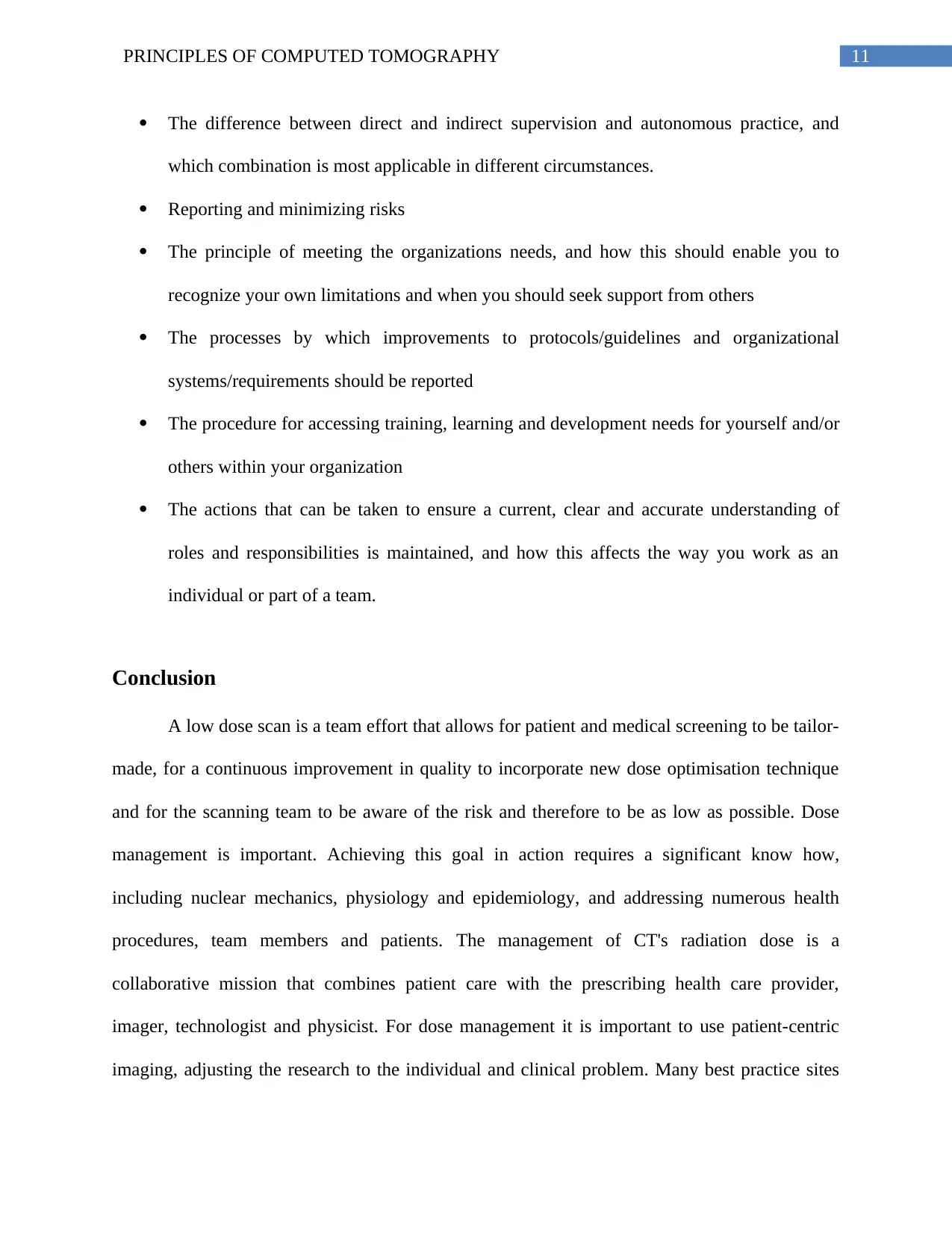
11PRINCIPLES OF COMPUTED TOMOGRAPHY
The difference between direct and indirect supervision and autonomous practice, and
which combination is most applicable in different circumstances.
Reporting and minimizing risks
The principle of meeting the organizations needs, and how this should enable you to
recognize your own limitations and when you should seek support from others
The processes by which improvements to protocols/guidelines and organizational
systems/requirements should be reported
The procedure for accessing training, learning and development needs for yourself and/or
others within your organization
The actions that can be taken to ensure a current, clear and accurate understanding of
roles and responsibilities is maintained, and how this affects the way you work as an
individual or part of a team.
Conclusion
A low dose scan is a team effort that allows for patient and medical screening to be tailor-
made, for a continuous improvement in quality to incorporate new dose optimisation technique
and for the scanning team to be aware of the risk and therefore to be as low as possible. Dose
management is important. Achieving this goal in action requires a significant know how,
including nuclear mechanics, physiology and epidemiology, and addressing numerous health
procedures, team members and patients. The management of CT's radiation dose is a
collaborative mission that combines patient care with the prescribing health care provider,
imager, technologist and physicist. For dose management it is important to use patient-centric
imaging, adjusting the research to the individual and clinical problem. Many best practice sites
The difference between direct and indirect supervision and autonomous practice, and
which combination is most applicable in different circumstances.
Reporting and minimizing risks
The principle of meeting the organizations needs, and how this should enable you to
recognize your own limitations and when you should seek support from others
The processes by which improvements to protocols/guidelines and organizational
systems/requirements should be reported
The procedure for accessing training, learning and development needs for yourself and/or
others within your organization
The actions that can be taken to ensure a current, clear and accurate understanding of
roles and responsibilities is maintained, and how this affects the way you work as an
individual or part of a team.
Conclusion
A low dose scan is a team effort that allows for patient and medical screening to be tailor-
made, for a continuous improvement in quality to incorporate new dose optimisation technique
and for the scanning team to be aware of the risk and therefore to be as low as possible. Dose
management is important. Achieving this goal in action requires a significant know how,
including nuclear mechanics, physiology and epidemiology, and addressing numerous health
procedures, team members and patients. The management of CT's radiation dose is a
collaborative mission that combines patient care with the prescribing health care provider,
imager, technologist and physicist. For dose management it is important to use patient-centric
imaging, adjusting the research to the individual and clinical problem. Many best practice sites

12PRINCIPLES OF COMPUTED TOMOGRAPHY
include the careful selection of tubes, current and potential, the reduction of the scanned range,
the use of iterative reconstruction and time-limited CT scans, among other applications.
include the careful selection of tubes, current and potential, the reduction of the scanned range,
the use of iterative reconstruction and time-limited CT scans, among other applications.
Paraphrase This Document
Need a fresh take? Get an instant paraphrase of this document with our AI Paraphraser
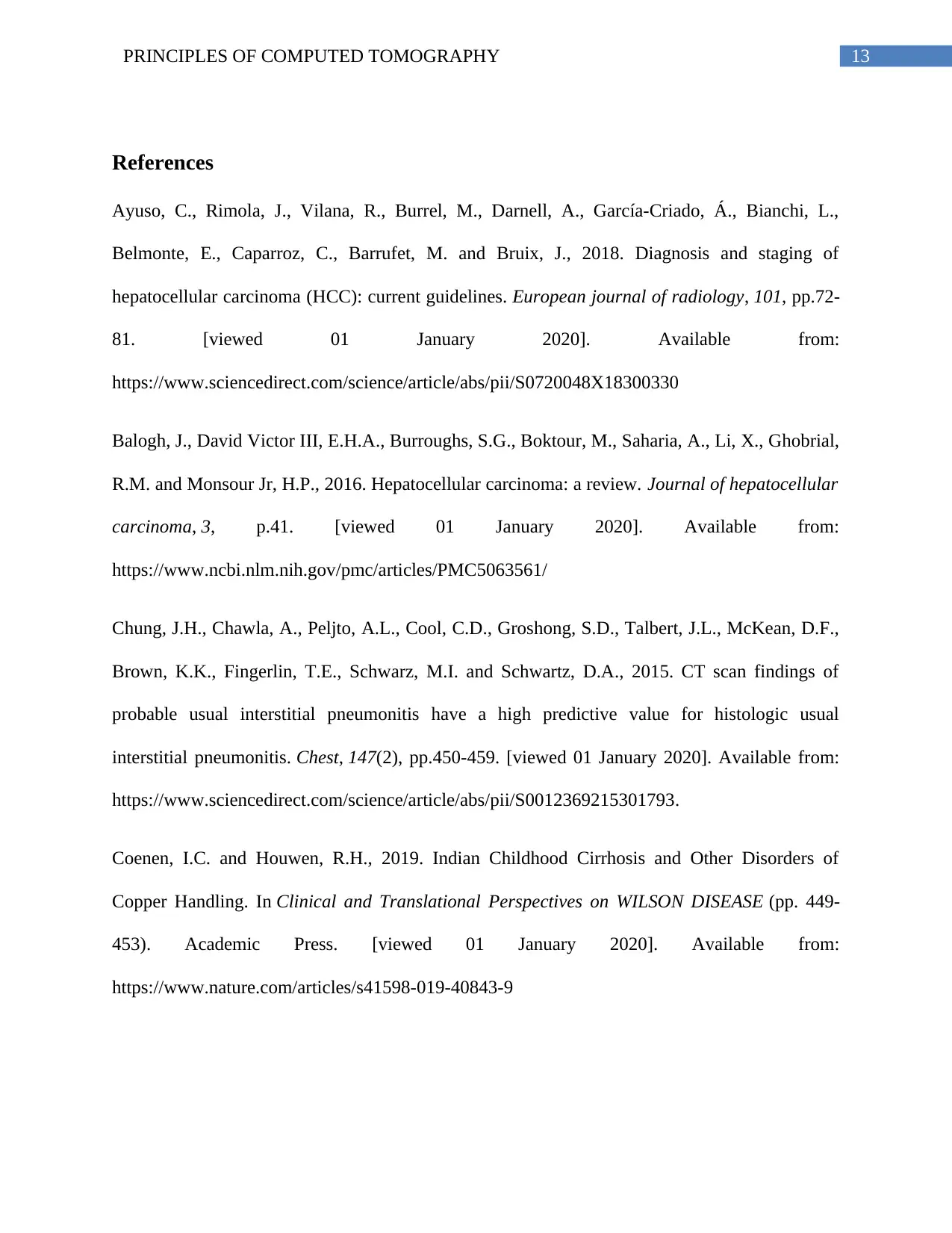
13PRINCIPLES OF COMPUTED TOMOGRAPHY
References
Ayuso, C., Rimola, J., Vilana, R., Burrel, M., Darnell, A., García-Criado, Á., Bianchi, L.,
Belmonte, E., Caparroz, C., Barrufet, M. and Bruix, J., 2018. Diagnosis and staging of
hepatocellular carcinoma (HCC): current guidelines. European journal of radiology, 101, pp.72-
81. [viewed 01 January 2020]. Available from:
https://www.sciencedirect.com/science/article/abs/pii/S0720048X18300330
Balogh, J., David Victor III, E.H.A., Burroughs, S.G., Boktour, M., Saharia, A., Li, X., Ghobrial,
R.M. and Monsour Jr, H.P., 2016. Hepatocellular carcinoma: a review. Journal of hepatocellular
carcinoma, 3, p.41. [viewed 01 January 2020]. Available from:
https://www.ncbi.nlm.nih.gov/pmc/articles/PMC5063561/
Chung, J.H., Chawla, A., Peljto, A.L., Cool, C.D., Groshong, S.D., Talbert, J.L., McKean, D.F.,
Brown, K.K., Fingerlin, T.E., Schwarz, M.I. and Schwartz, D.A., 2015. CT scan findings of
probable usual interstitial pneumonitis have a high predictive value for histologic usual
interstitial pneumonitis. Chest, 147(2), pp.450-459. [viewed 01 January 2020]. Available from:
https://www.sciencedirect.com/science/article/abs/pii/S0012369215301793.
Coenen, I.C. and Houwen, R.H., 2019. Indian Childhood Cirrhosis and Other Disorders of
Copper Handling. In Clinical and Translational Perspectives on WILSON DISEASE (pp. 449-
453). Academic Press. [viewed 01 January 2020]. Available from:
https://www.nature.com/articles/s41598-019-40843-9
References
Ayuso, C., Rimola, J., Vilana, R., Burrel, M., Darnell, A., García-Criado, Á., Bianchi, L.,
Belmonte, E., Caparroz, C., Barrufet, M. and Bruix, J., 2018. Diagnosis and staging of
hepatocellular carcinoma (HCC): current guidelines. European journal of radiology, 101, pp.72-
81. [viewed 01 January 2020]. Available from:
https://www.sciencedirect.com/science/article/abs/pii/S0720048X18300330
Balogh, J., David Victor III, E.H.A., Burroughs, S.G., Boktour, M., Saharia, A., Li, X., Ghobrial,
R.M. and Monsour Jr, H.P., 2016. Hepatocellular carcinoma: a review. Journal of hepatocellular
carcinoma, 3, p.41. [viewed 01 January 2020]. Available from:
https://www.ncbi.nlm.nih.gov/pmc/articles/PMC5063561/
Chung, J.H., Chawla, A., Peljto, A.L., Cool, C.D., Groshong, S.D., Talbert, J.L., McKean, D.F.,
Brown, K.K., Fingerlin, T.E., Schwarz, M.I. and Schwartz, D.A., 2015. CT scan findings of
probable usual interstitial pneumonitis have a high predictive value for histologic usual
interstitial pneumonitis. Chest, 147(2), pp.450-459. [viewed 01 January 2020]. Available from:
https://www.sciencedirect.com/science/article/abs/pii/S0012369215301793.
Coenen, I.C. and Houwen, R.H., 2019. Indian Childhood Cirrhosis and Other Disorders of
Copper Handling. In Clinical and Translational Perspectives on WILSON DISEASE (pp. 449-
453). Academic Press. [viewed 01 January 2020]. Available from:
https://www.nature.com/articles/s41598-019-40843-9
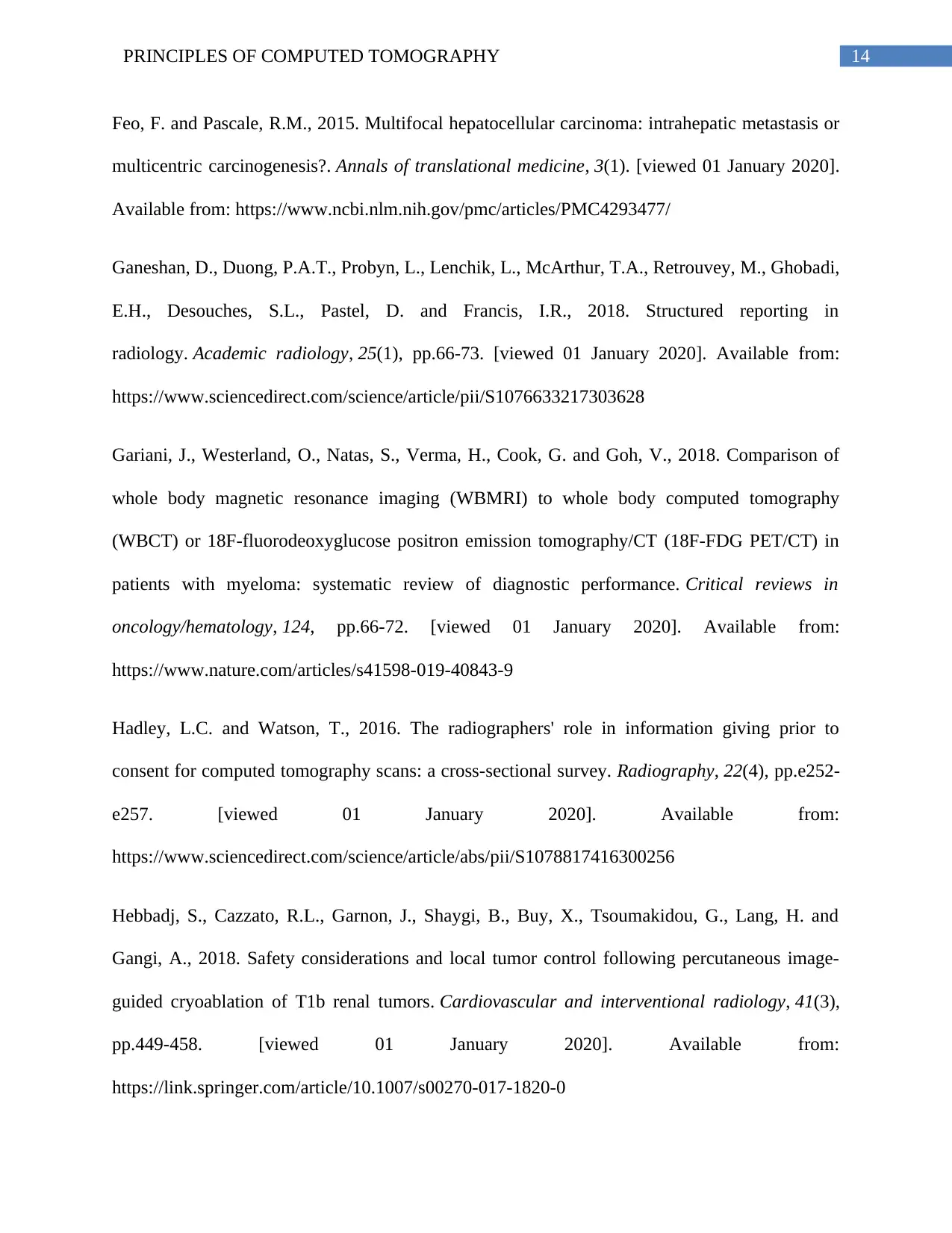
14PRINCIPLES OF COMPUTED TOMOGRAPHY
Feo, F. and Pascale, R.M., 2015. Multifocal hepatocellular carcinoma: intrahepatic metastasis or
multicentric carcinogenesis?. Annals of translational medicine, 3(1). [viewed 01 January 2020].
Available from: https://www.ncbi.nlm.nih.gov/pmc/articles/PMC4293477/
Ganeshan, D., Duong, P.A.T., Probyn, L., Lenchik, L., McArthur, T.A., Retrouvey, M., Ghobadi,
E.H., Desouches, S.L., Pastel, D. and Francis, I.R., 2018. Structured reporting in
radiology. Academic radiology, 25(1), pp.66-73. [viewed 01 January 2020]. Available from:
https://www.sciencedirect.com/science/article/pii/S1076633217303628
Gariani, J., Westerland, O., Natas, S., Verma, H., Cook, G. and Goh, V., 2018. Comparison of
whole body magnetic resonance imaging (WBMRI) to whole body computed tomography
(WBCT) or 18F-fluorodeoxyglucose positron emission tomography/CT (18F-FDG PET/CT) in
patients with myeloma: systematic review of diagnostic performance. Critical reviews in
oncology/hematology, 124, pp.66-72. [viewed 01 January 2020]. Available from:
https://www.nature.com/articles/s41598-019-40843-9
Hadley, L.C. and Watson, T., 2016. The radiographers' role in information giving prior to
consent for computed tomography scans: a cross-sectional survey. Radiography, 22(4), pp.e252-
e257. [viewed 01 January 2020]. Available from:
https://www.sciencedirect.com/science/article/abs/pii/S1078817416300256
Hebbadj, S., Cazzato, R.L., Garnon, J., Shaygi, B., Buy, X., Tsoumakidou, G., Lang, H. and
Gangi, A., 2018. Safety considerations and local tumor control following percutaneous image-
guided cryoablation of T1b renal tumors. Cardiovascular and interventional radiology, 41(3),
pp.449-458. [viewed 01 January 2020]. Available from:
https://link.springer.com/article/10.1007/s00270-017-1820-0
Feo, F. and Pascale, R.M., 2015. Multifocal hepatocellular carcinoma: intrahepatic metastasis or
multicentric carcinogenesis?. Annals of translational medicine, 3(1). [viewed 01 January 2020].
Available from: https://www.ncbi.nlm.nih.gov/pmc/articles/PMC4293477/
Ganeshan, D., Duong, P.A.T., Probyn, L., Lenchik, L., McArthur, T.A., Retrouvey, M., Ghobadi,
E.H., Desouches, S.L., Pastel, D. and Francis, I.R., 2018. Structured reporting in
radiology. Academic radiology, 25(1), pp.66-73. [viewed 01 January 2020]. Available from:
https://www.sciencedirect.com/science/article/pii/S1076633217303628
Gariani, J., Westerland, O., Natas, S., Verma, H., Cook, G. and Goh, V., 2018. Comparison of
whole body magnetic resonance imaging (WBMRI) to whole body computed tomography
(WBCT) or 18F-fluorodeoxyglucose positron emission tomography/CT (18F-FDG PET/CT) in
patients with myeloma: systematic review of diagnostic performance. Critical reviews in
oncology/hematology, 124, pp.66-72. [viewed 01 January 2020]. Available from:
https://www.nature.com/articles/s41598-019-40843-9
Hadley, L.C. and Watson, T., 2016. The radiographers' role in information giving prior to
consent for computed tomography scans: a cross-sectional survey. Radiography, 22(4), pp.e252-
e257. [viewed 01 January 2020]. Available from:
https://www.sciencedirect.com/science/article/abs/pii/S1078817416300256
Hebbadj, S., Cazzato, R.L., Garnon, J., Shaygi, B., Buy, X., Tsoumakidou, G., Lang, H. and
Gangi, A., 2018. Safety considerations and local tumor control following percutaneous image-
guided cryoablation of T1b renal tumors. Cardiovascular and interventional radiology, 41(3),
pp.449-458. [viewed 01 January 2020]. Available from:
https://link.springer.com/article/10.1007/s00270-017-1820-0
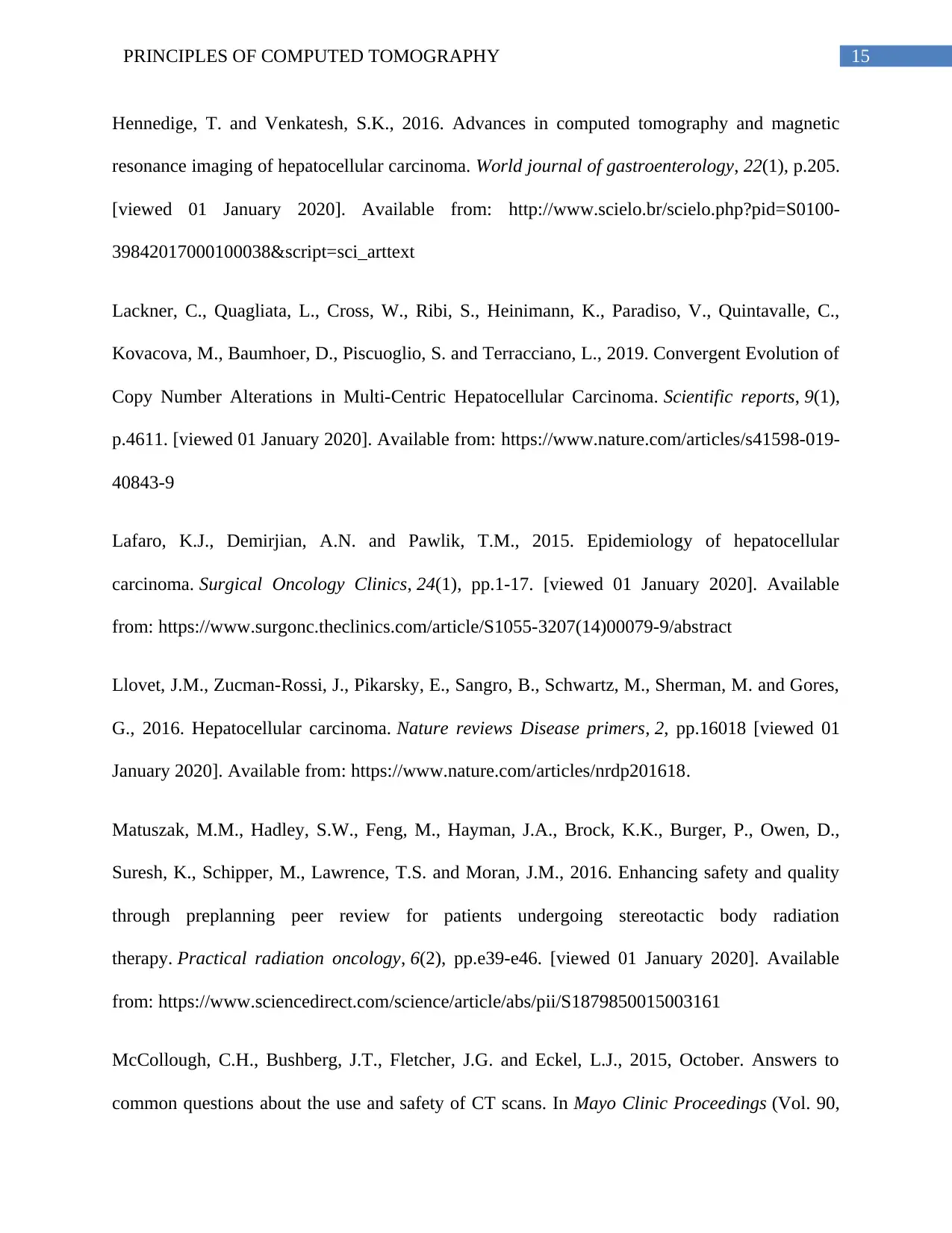
15PRINCIPLES OF COMPUTED TOMOGRAPHY
Hennedige, T. and Venkatesh, S.K., 2016. Advances in computed tomography and magnetic
resonance imaging of hepatocellular carcinoma. World journal of gastroenterology, 22(1), p.205.
[viewed 01 January 2020]. Available from: http://www.scielo.br/scielo.php?pid=S0100-
39842017000100038&script=sci_arttext
Lackner, C., Quagliata, L., Cross, W., Ribi, S., Heinimann, K., Paradiso, V., Quintavalle, C.,
Kovacova, M., Baumhoer, D., Piscuoglio, S. and Terracciano, L., 2019. Convergent Evolution of
Copy Number Alterations in Multi-Centric Hepatocellular Carcinoma. Scientific reports, 9(1),
p.4611. [viewed 01 January 2020]. Available from: https://www.nature.com/articles/s41598-019-
40843-9
Lafaro, K.J., Demirjian, A.N. and Pawlik, T.M., 2015. Epidemiology of hepatocellular
carcinoma. Surgical Oncology Clinics, 24(1), pp.1-17. [viewed 01 January 2020]. Available
from: https://www.surgonc.theclinics.com/article/S1055-3207(14)00079-9/abstract
Llovet, J.M., Zucman-Rossi, J., Pikarsky, E., Sangro, B., Schwartz, M., Sherman, M. and Gores,
G., 2016. Hepatocellular carcinoma. Nature reviews Disease primers, 2, pp.16018 [viewed 01
January 2020]. Available from: https://www.nature.com/articles/nrdp201618.
Matuszak, M.M., Hadley, S.W., Feng, M., Hayman, J.A., Brock, K.K., Burger, P., Owen, D.,
Suresh, K., Schipper, M., Lawrence, T.S. and Moran, J.M., 2016. Enhancing safety and quality
through preplanning peer review for patients undergoing stereotactic body radiation
therapy. Practical radiation oncology, 6(2), pp.e39-e46. [viewed 01 January 2020]. Available
from: https://www.sciencedirect.com/science/article/abs/pii/S1879850015003161
McCollough, C.H., Bushberg, J.T., Fletcher, J.G. and Eckel, L.J., 2015, October. Answers to
common questions about the use and safety of CT scans. In Mayo Clinic Proceedings (Vol. 90,
Hennedige, T. and Venkatesh, S.K., 2016. Advances in computed tomography and magnetic
resonance imaging of hepatocellular carcinoma. World journal of gastroenterology, 22(1), p.205.
[viewed 01 January 2020]. Available from: http://www.scielo.br/scielo.php?pid=S0100-
39842017000100038&script=sci_arttext
Lackner, C., Quagliata, L., Cross, W., Ribi, S., Heinimann, K., Paradiso, V., Quintavalle, C.,
Kovacova, M., Baumhoer, D., Piscuoglio, S. and Terracciano, L., 2019. Convergent Evolution of
Copy Number Alterations in Multi-Centric Hepatocellular Carcinoma. Scientific reports, 9(1),
p.4611. [viewed 01 January 2020]. Available from: https://www.nature.com/articles/s41598-019-
40843-9
Lafaro, K.J., Demirjian, A.N. and Pawlik, T.M., 2015. Epidemiology of hepatocellular
carcinoma. Surgical Oncology Clinics, 24(1), pp.1-17. [viewed 01 January 2020]. Available
from: https://www.surgonc.theclinics.com/article/S1055-3207(14)00079-9/abstract
Llovet, J.M., Zucman-Rossi, J., Pikarsky, E., Sangro, B., Schwartz, M., Sherman, M. and Gores,
G., 2016. Hepatocellular carcinoma. Nature reviews Disease primers, 2, pp.16018 [viewed 01
January 2020]. Available from: https://www.nature.com/articles/nrdp201618.
Matuszak, M.M., Hadley, S.W., Feng, M., Hayman, J.A., Brock, K.K., Burger, P., Owen, D.,
Suresh, K., Schipper, M., Lawrence, T.S. and Moran, J.M., 2016. Enhancing safety and quality
through preplanning peer review for patients undergoing stereotactic body radiation
therapy. Practical radiation oncology, 6(2), pp.e39-e46. [viewed 01 January 2020]. Available
from: https://www.sciencedirect.com/science/article/abs/pii/S1879850015003161
McCollough, C.H., Bushberg, J.T., Fletcher, J.G. and Eckel, L.J., 2015, October. Answers to
common questions about the use and safety of CT scans. In Mayo Clinic Proceedings (Vol. 90,
Secure Best Marks with AI Grader
Need help grading? Try our AI Grader for instant feedback on your assignments.
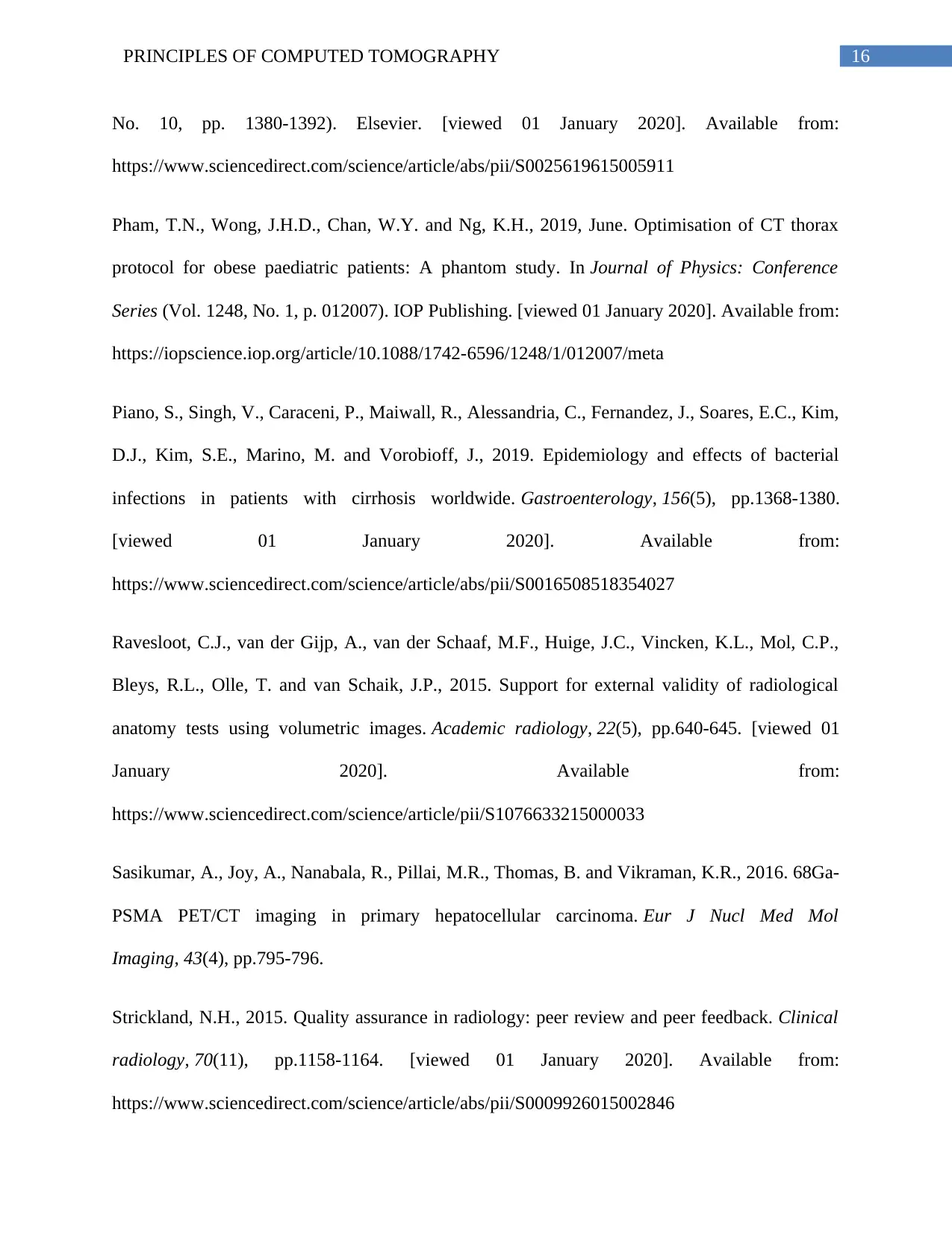
16PRINCIPLES OF COMPUTED TOMOGRAPHY
No. 10, pp. 1380-1392). Elsevier. [viewed 01 January 2020]. Available from:
https://www.sciencedirect.com/science/article/abs/pii/S0025619615005911
Pham, T.N., Wong, J.H.D., Chan, W.Y. and Ng, K.H., 2019, June. Optimisation of CT thorax
protocol for obese paediatric patients: A phantom study. In Journal of Physics: Conference
Series (Vol. 1248, No. 1, p. 012007). IOP Publishing. [viewed 01 January 2020]. Available from:
https://iopscience.iop.org/article/10.1088/1742-6596/1248/1/012007/meta
Piano, S., Singh, V., Caraceni, P., Maiwall, R., Alessandria, C., Fernandez, J., Soares, E.C., Kim,
D.J., Kim, S.E., Marino, M. and Vorobioff, J., 2019. Epidemiology and effects of bacterial
infections in patients with cirrhosis worldwide. Gastroenterology, 156(5), pp.1368-1380.
[viewed 01 January 2020]. Available from:
https://www.sciencedirect.com/science/article/abs/pii/S0016508518354027
Ravesloot, C.J., van der Gijp, A., van der Schaaf, M.F., Huige, J.C., Vincken, K.L., Mol, C.P.,
Bleys, R.L., Olle, T. and van Schaik, J.P., 2015. Support for external validity of radiological
anatomy tests using volumetric images. Academic radiology, 22(5), pp.640-645. [viewed 01
January 2020]. Available from:
https://www.sciencedirect.com/science/article/pii/S1076633215000033
Sasikumar, A., Joy, A., Nanabala, R., Pillai, M.R., Thomas, B. and Vikraman, K.R., 2016. 68Ga-
PSMA PET/CT imaging in primary hepatocellular carcinoma. Eur J Nucl Med Mol
Imaging, 43(4), pp.795-796.
Strickland, N.H., 2015. Quality assurance in radiology: peer review and peer feedback. Clinical
radiology, 70(11), pp.1158-1164. [viewed 01 January 2020]. Available from:
https://www.sciencedirect.com/science/article/abs/pii/S0009926015002846
No. 10, pp. 1380-1392). Elsevier. [viewed 01 January 2020]. Available from:
https://www.sciencedirect.com/science/article/abs/pii/S0025619615005911
Pham, T.N., Wong, J.H.D., Chan, W.Y. and Ng, K.H., 2019, June. Optimisation of CT thorax
protocol for obese paediatric patients: A phantom study. In Journal of Physics: Conference
Series (Vol. 1248, No. 1, p. 012007). IOP Publishing. [viewed 01 January 2020]. Available from:
https://iopscience.iop.org/article/10.1088/1742-6596/1248/1/012007/meta
Piano, S., Singh, V., Caraceni, P., Maiwall, R., Alessandria, C., Fernandez, J., Soares, E.C., Kim,
D.J., Kim, S.E., Marino, M. and Vorobioff, J., 2019. Epidemiology and effects of bacterial
infections in patients with cirrhosis worldwide. Gastroenterology, 156(5), pp.1368-1380.
[viewed 01 January 2020]. Available from:
https://www.sciencedirect.com/science/article/abs/pii/S0016508518354027
Ravesloot, C.J., van der Gijp, A., van der Schaaf, M.F., Huige, J.C., Vincken, K.L., Mol, C.P.,
Bleys, R.L., Olle, T. and van Schaik, J.P., 2015. Support for external validity of radiological
anatomy tests using volumetric images. Academic radiology, 22(5), pp.640-645. [viewed 01
January 2020]. Available from:
https://www.sciencedirect.com/science/article/pii/S1076633215000033
Sasikumar, A., Joy, A., Nanabala, R., Pillai, M.R., Thomas, B. and Vikraman, K.R., 2016. 68Ga-
PSMA PET/CT imaging in primary hepatocellular carcinoma. Eur J Nucl Med Mol
Imaging, 43(4), pp.795-796.
Strickland, N.H., 2015. Quality assurance in radiology: peer review and peer feedback. Clinical
radiology, 70(11), pp.1158-1164. [viewed 01 January 2020]. Available from:
https://www.sciencedirect.com/science/article/abs/pii/S0009926015002846

17PRINCIPLES OF COMPUTED TOMOGRAPHY
Trattner, S., Pearson, G.D., Chin, C., Cody, D.D., Gupta, R., Hess, C.P., Kalra, M.K., Kofler Jr,
J.M., Krishnam, M.S. and Einstein, A.J., 2014. Standardization and optimization of CT protocols
to achieve low dose. Journal of the American College of Radiology, 11(3), pp.271-278.
Trattner, S., Pearson, G.D., Chin, C., Cody, D.D., Gupta, R., Hess, C.P., Kalra, M.K., Kofler Jr,
J.M., Krishnam, M.S. and Einstein, A.J., 2014. Standardization and optimization of CT protocols
to achieve low dose. Journal of the American College of Radiology, 11(3), pp.271-278.
1 out of 18
Related Documents
Your All-in-One AI-Powered Toolkit for Academic Success.
+13062052269
info@desklib.com
Available 24*7 on WhatsApp / Email
![[object Object]](/_next/static/media/star-bottom.7253800d.svg)
Unlock your academic potential
© 2024 | Zucol Services PVT LTD | All rights reserved.




